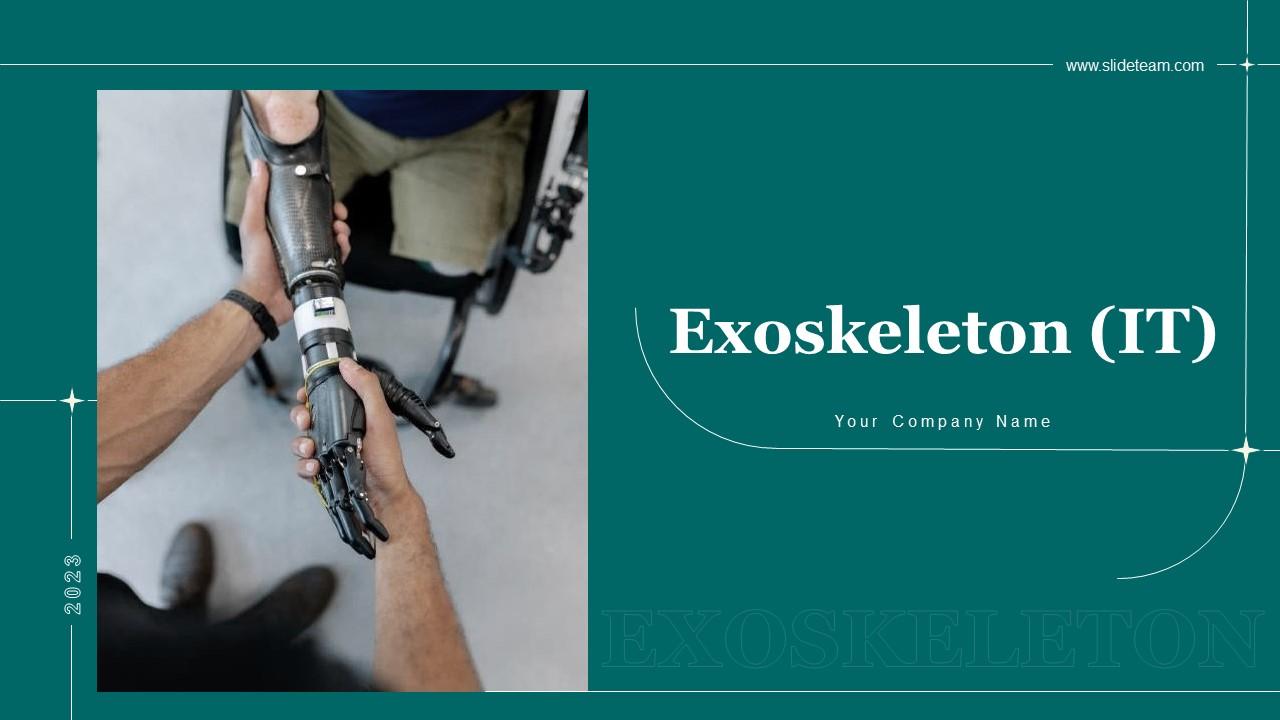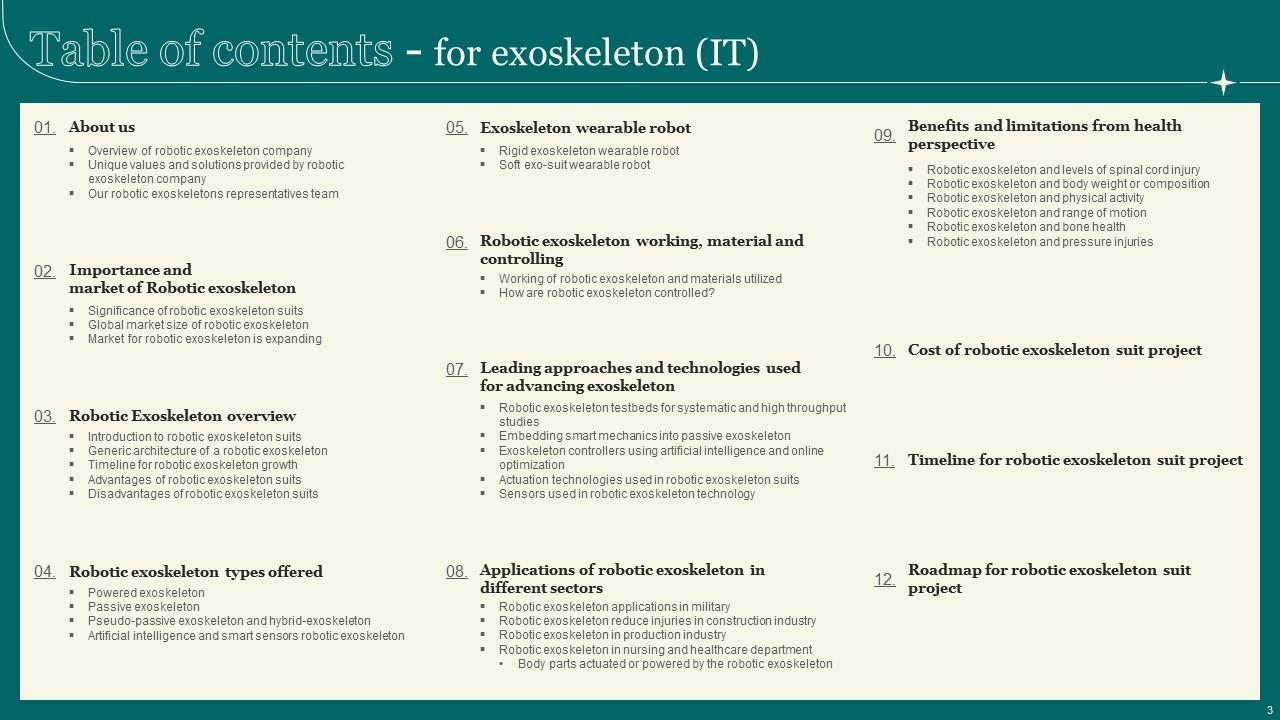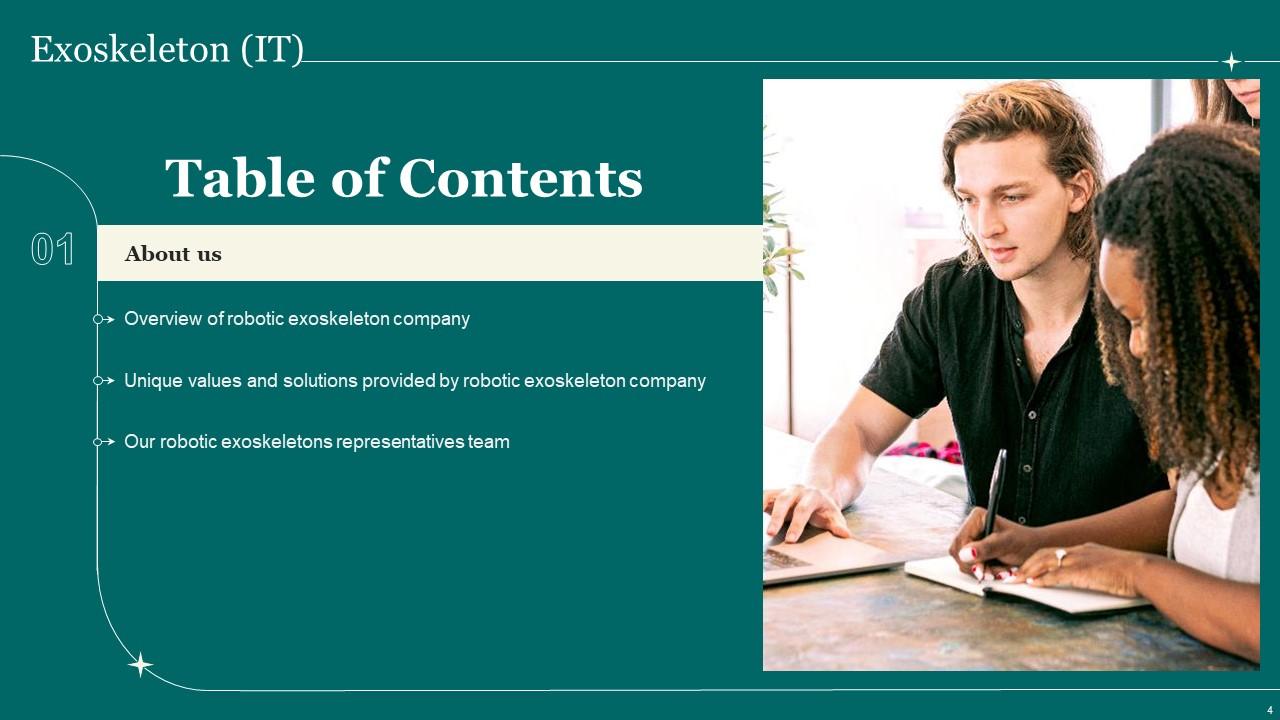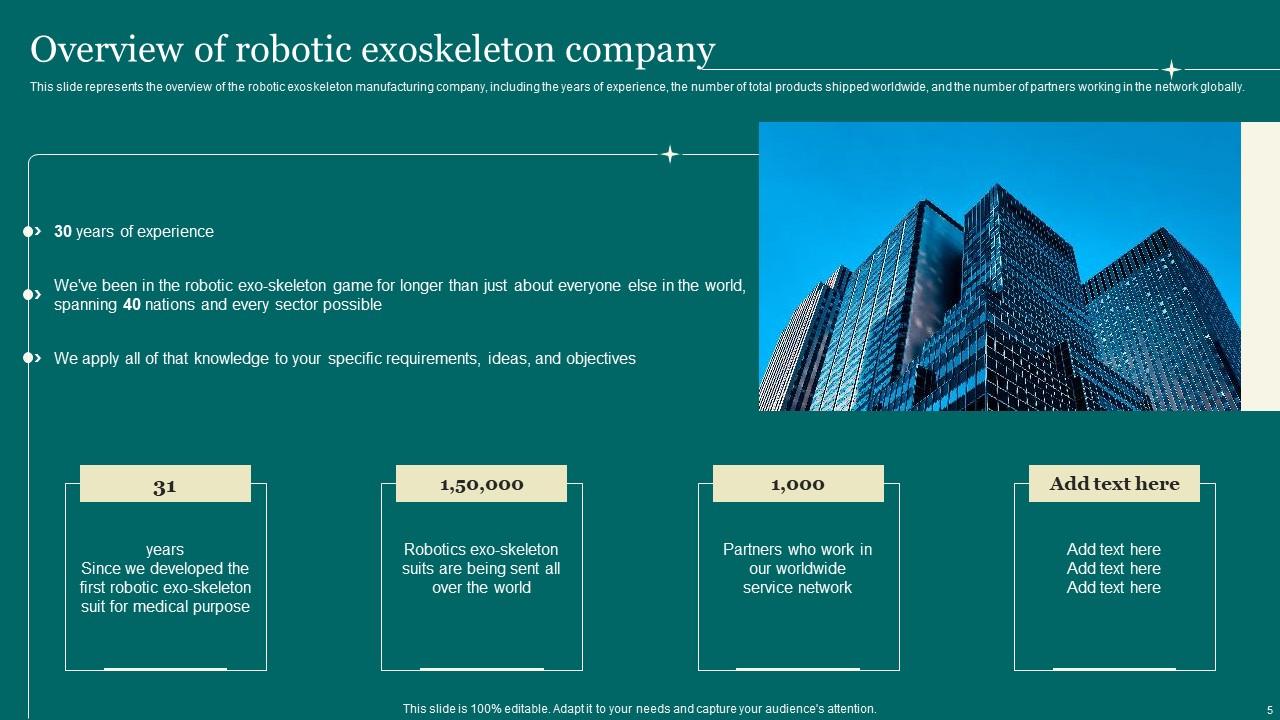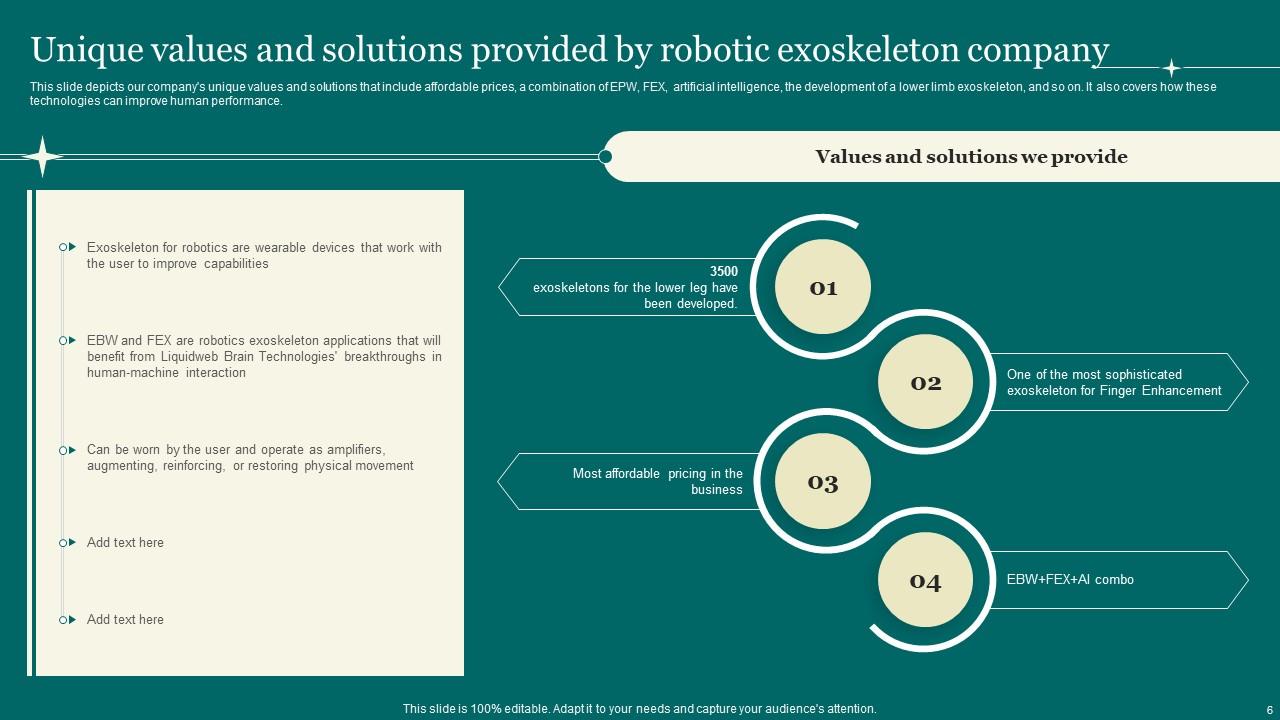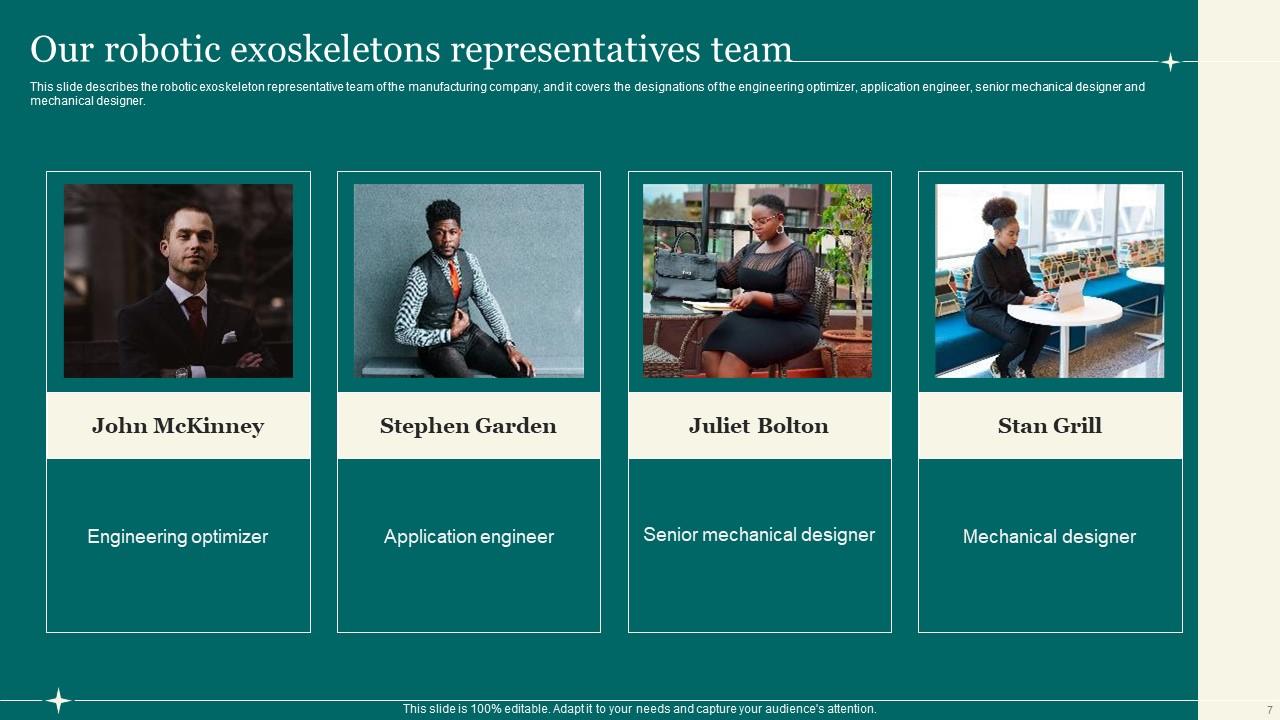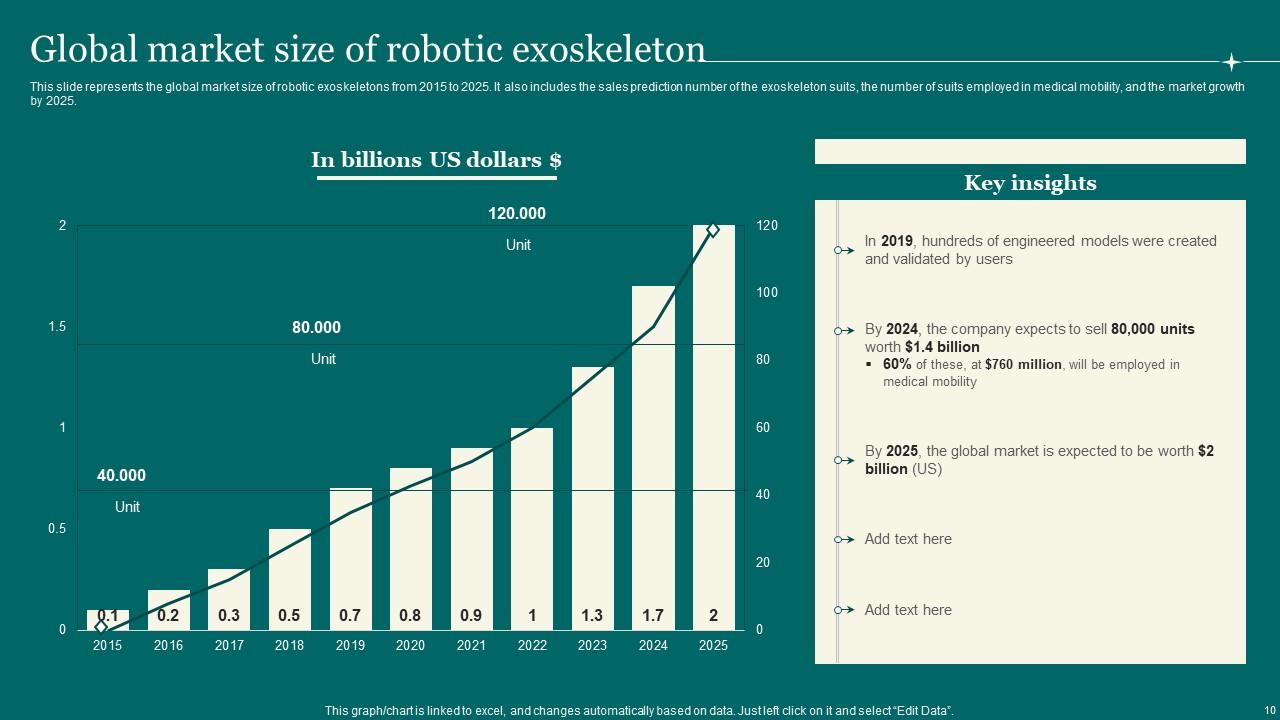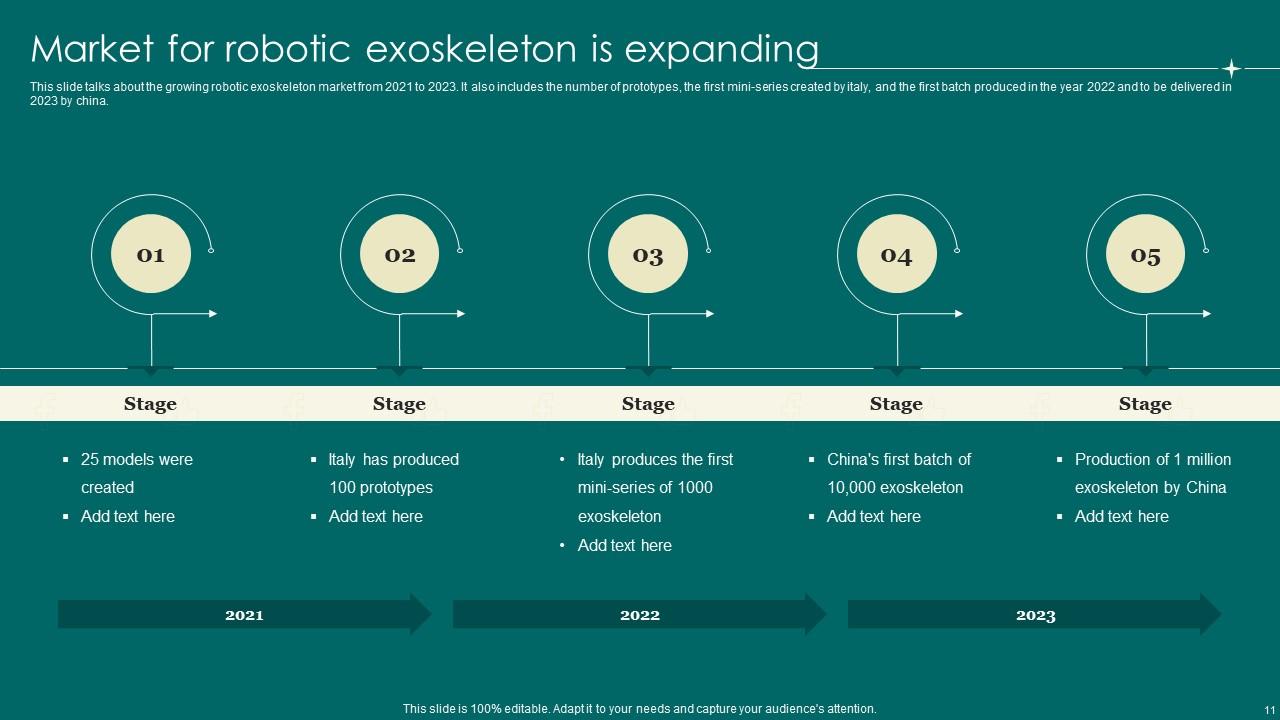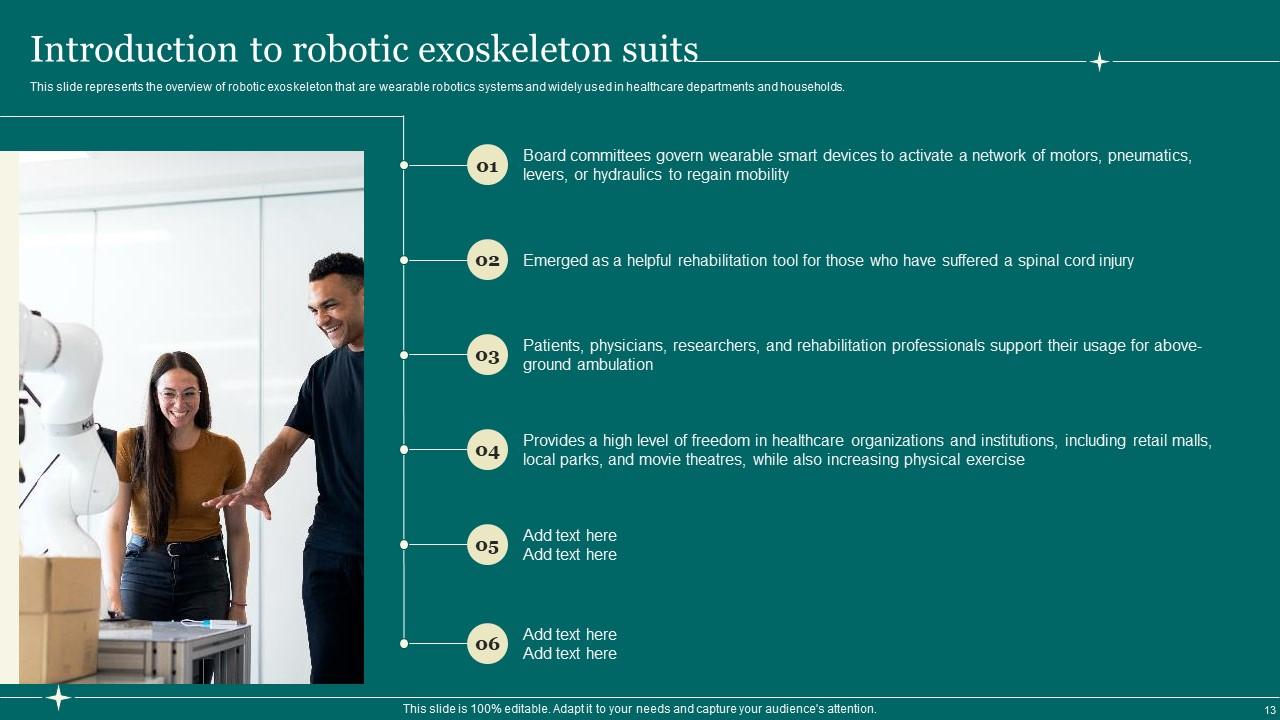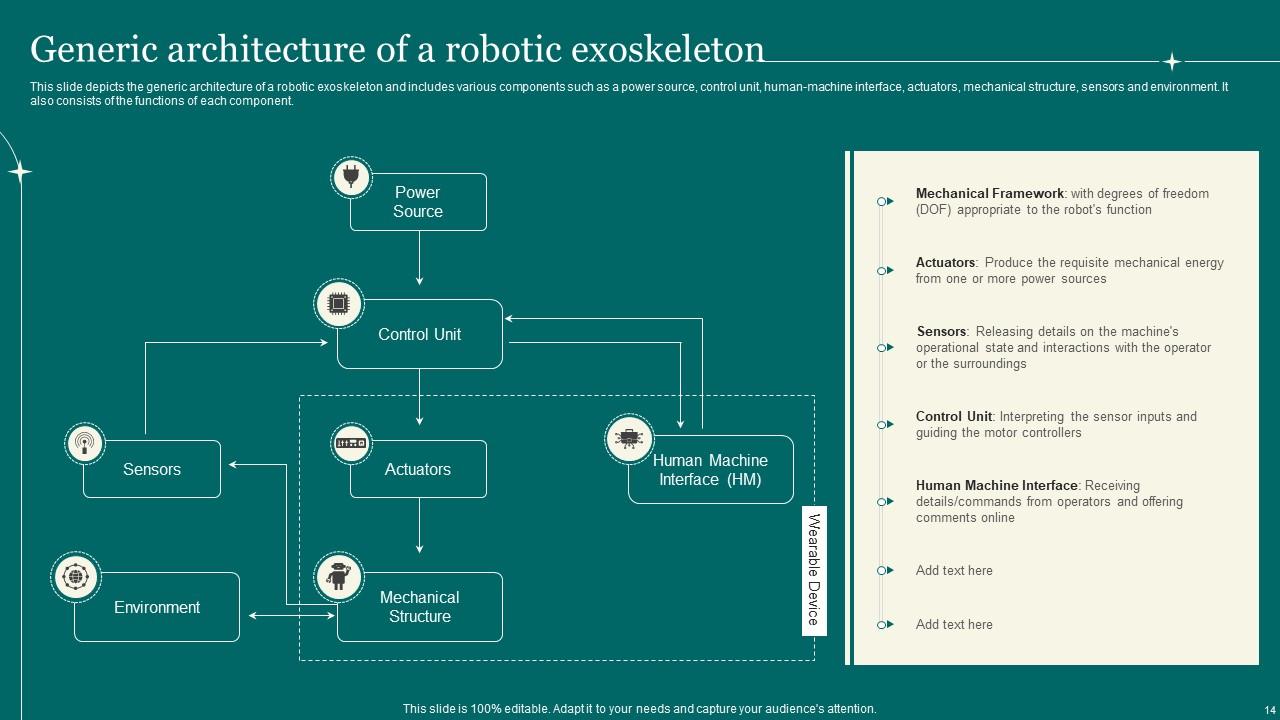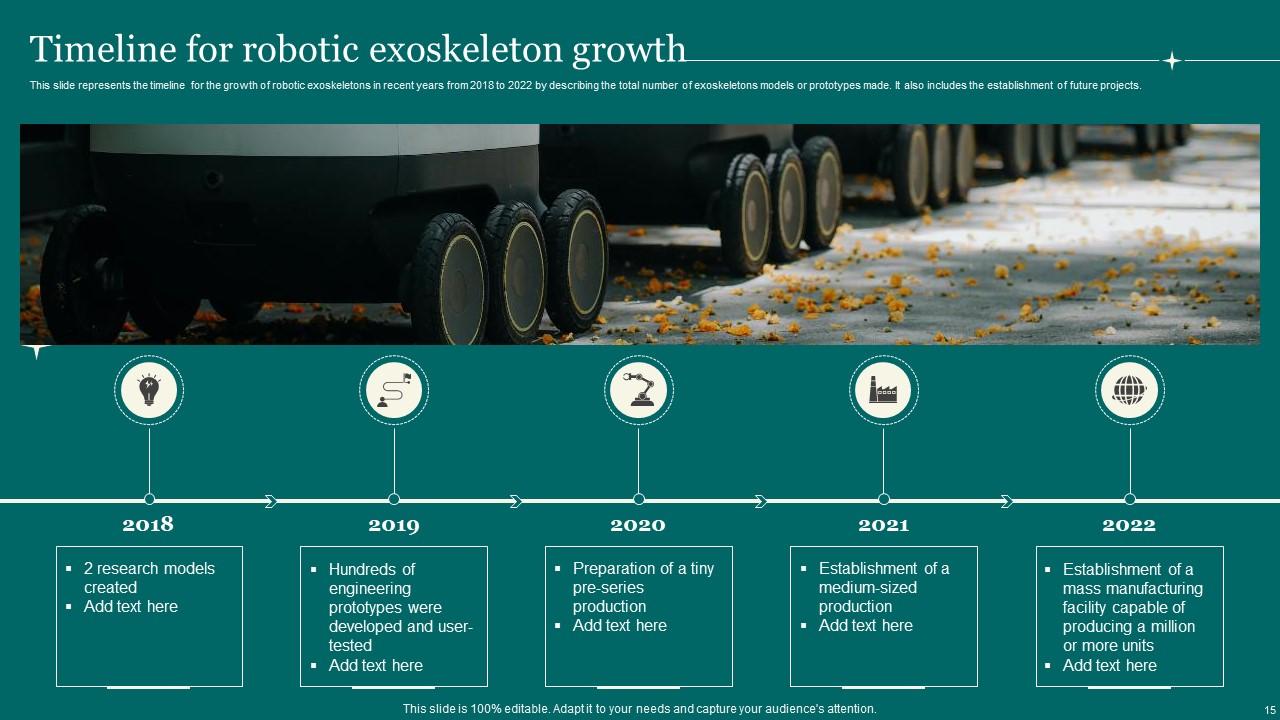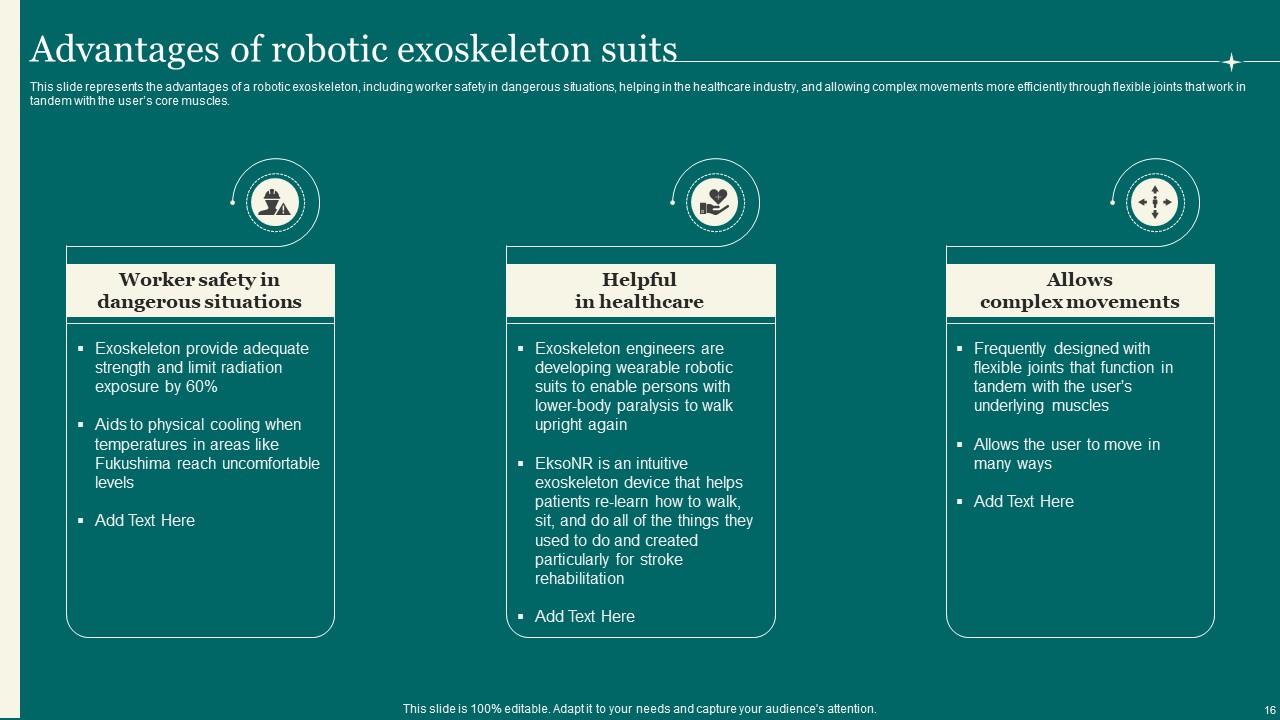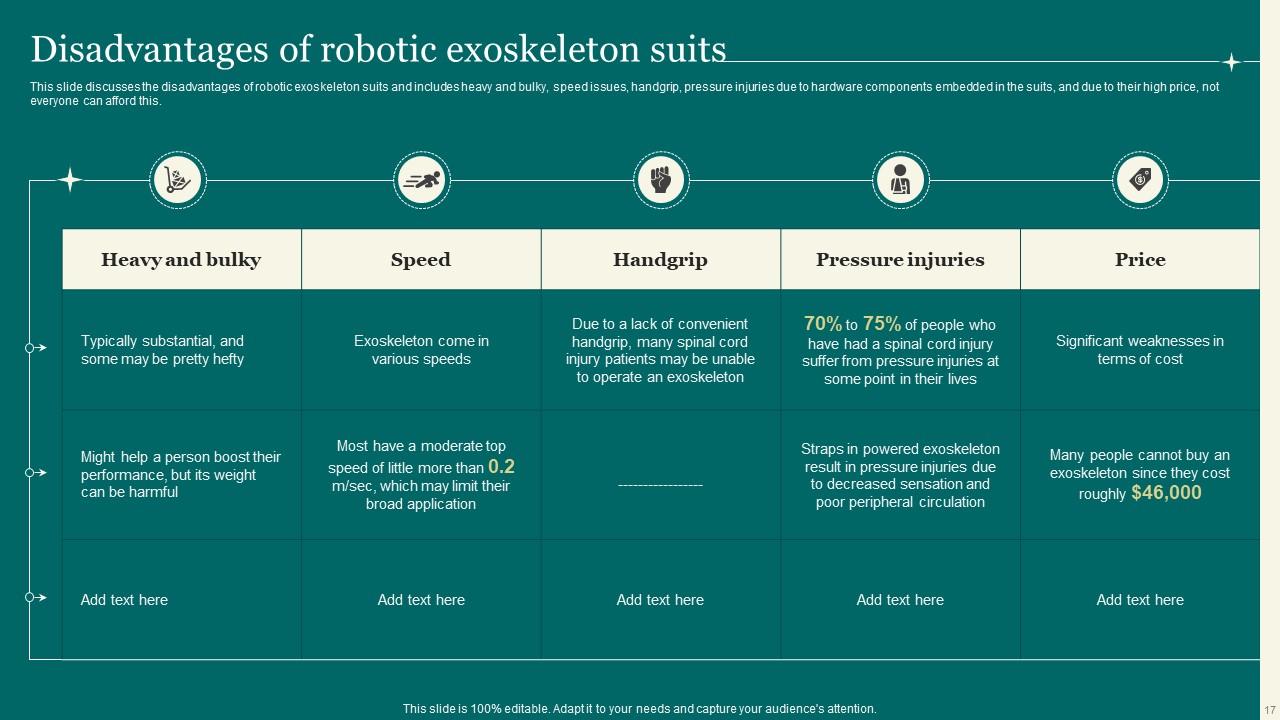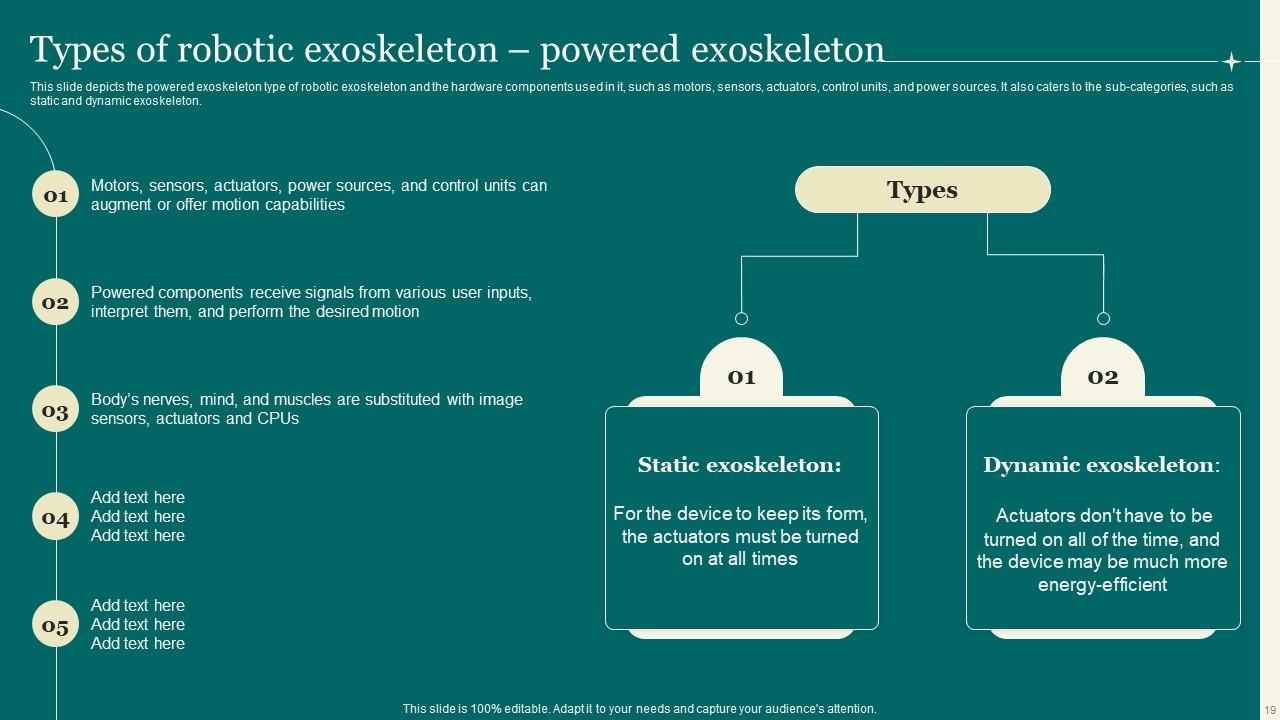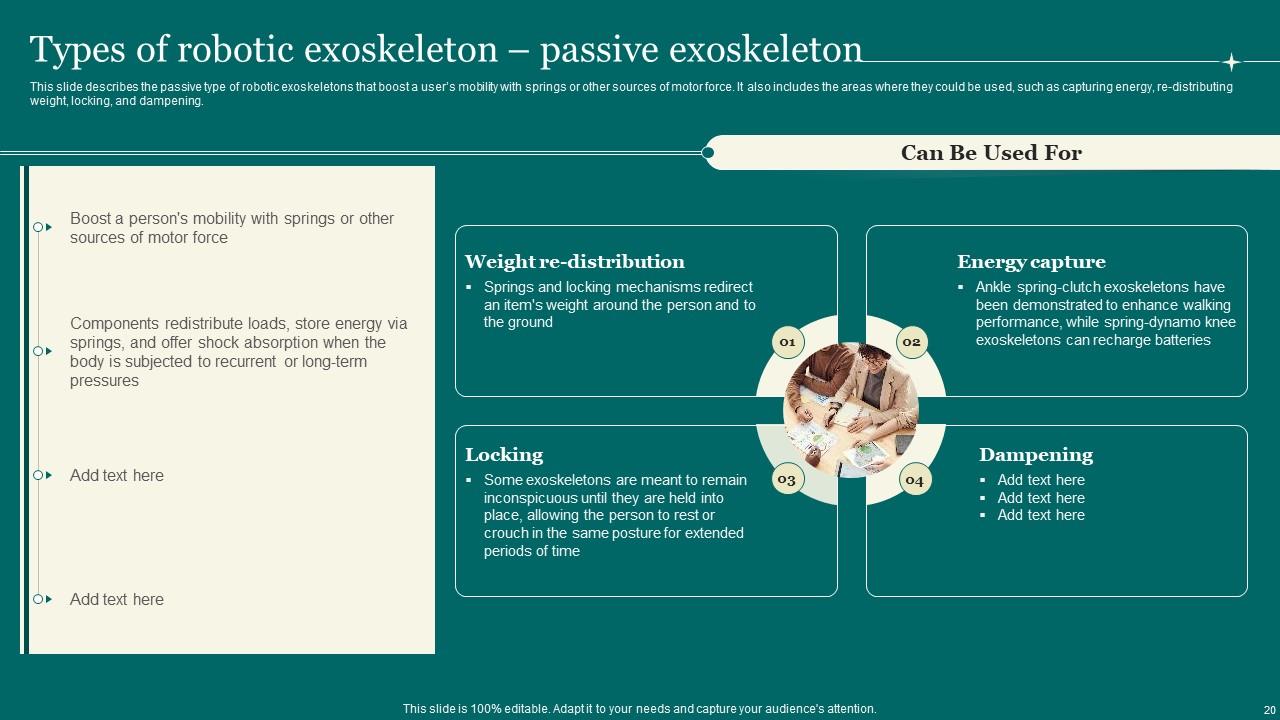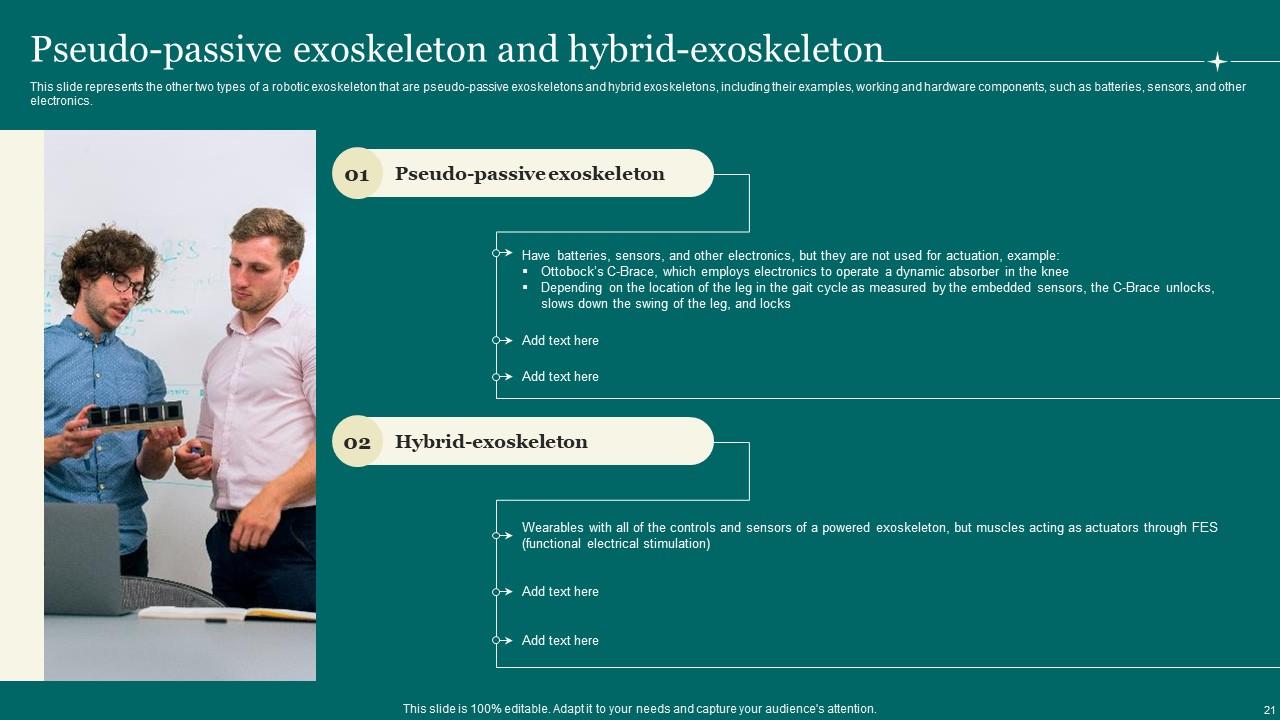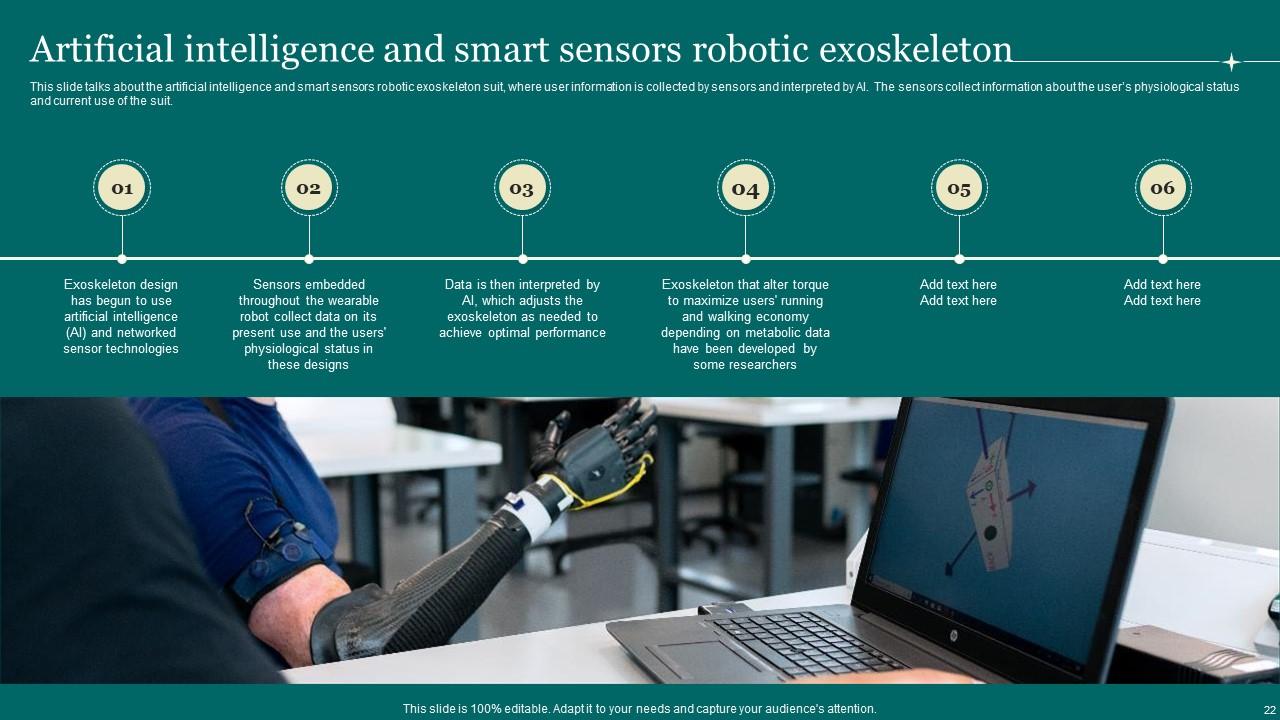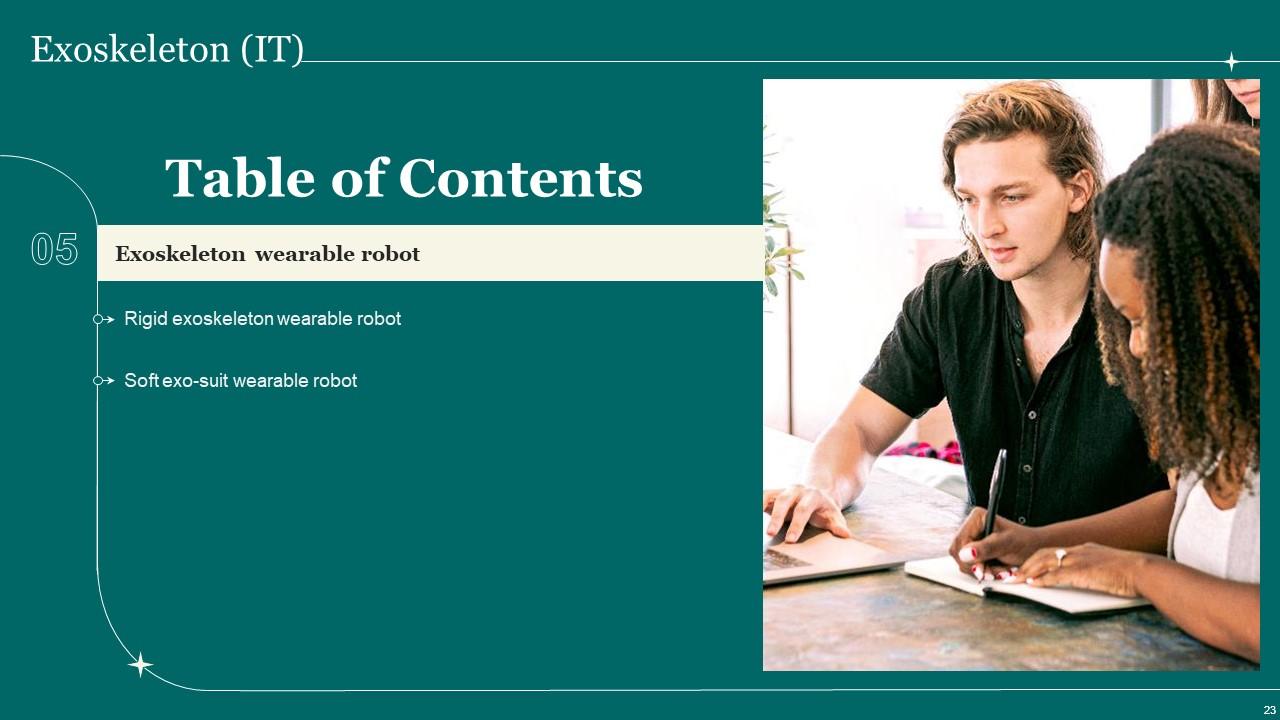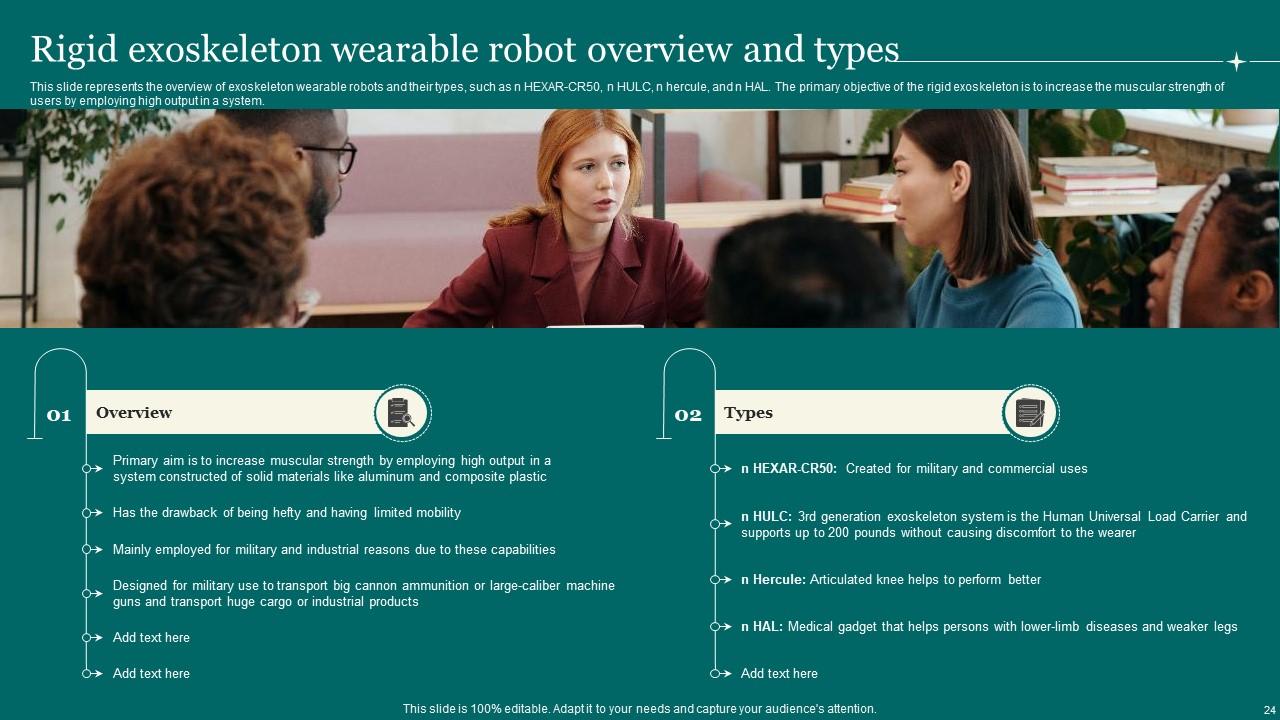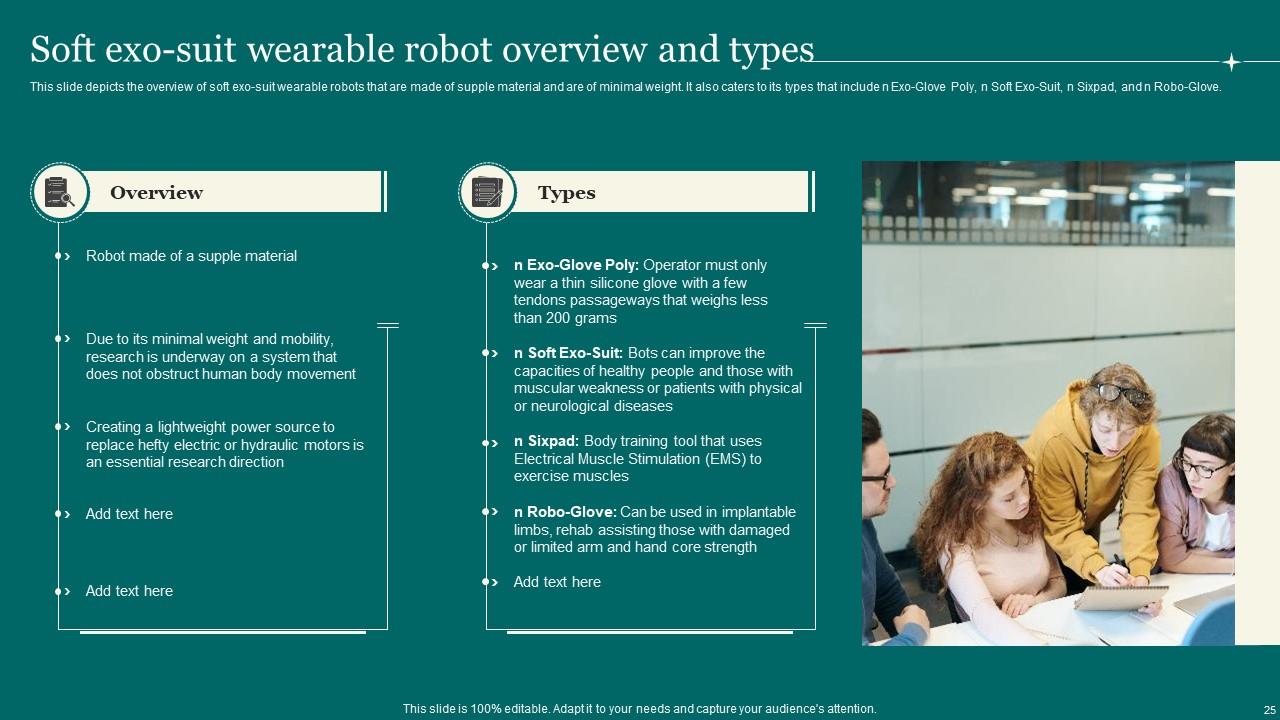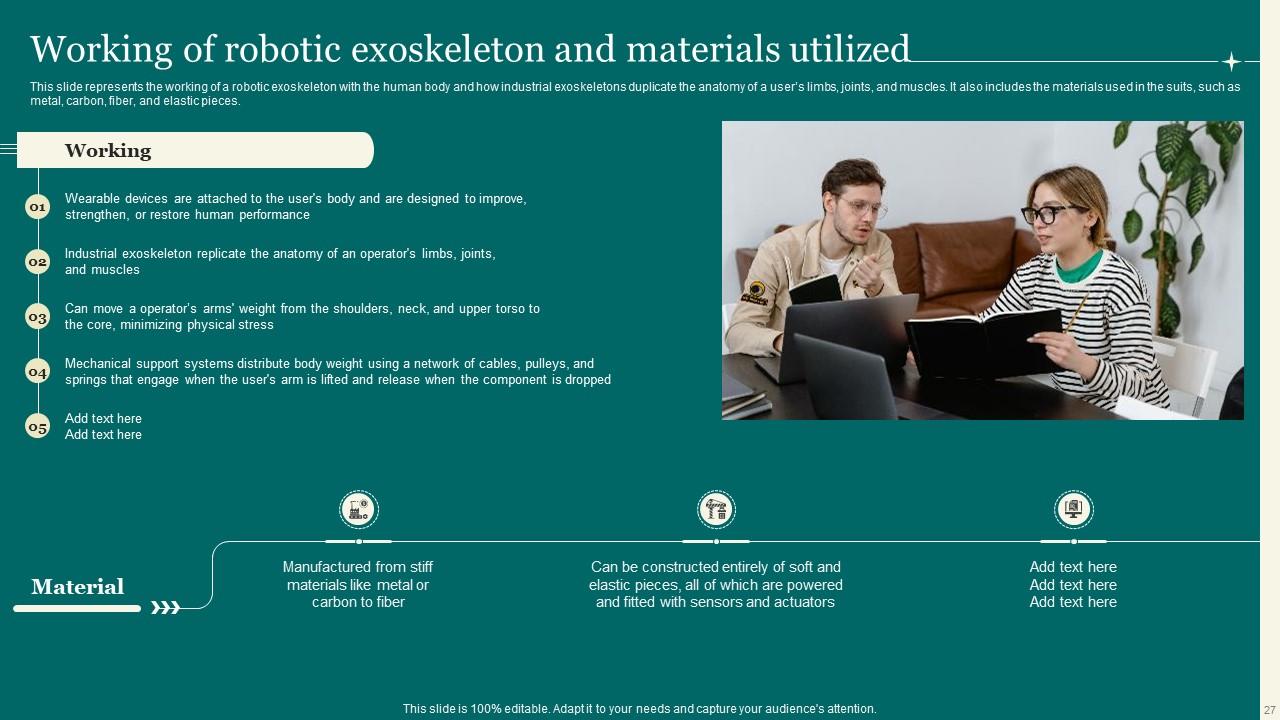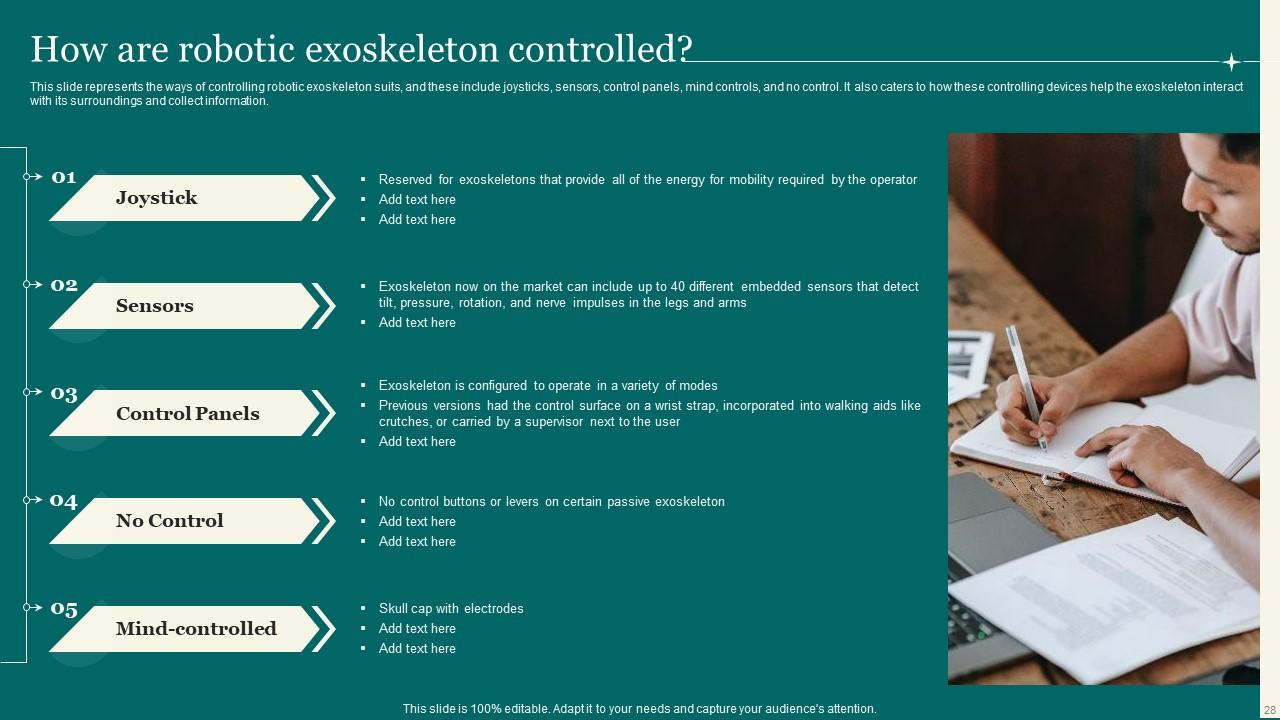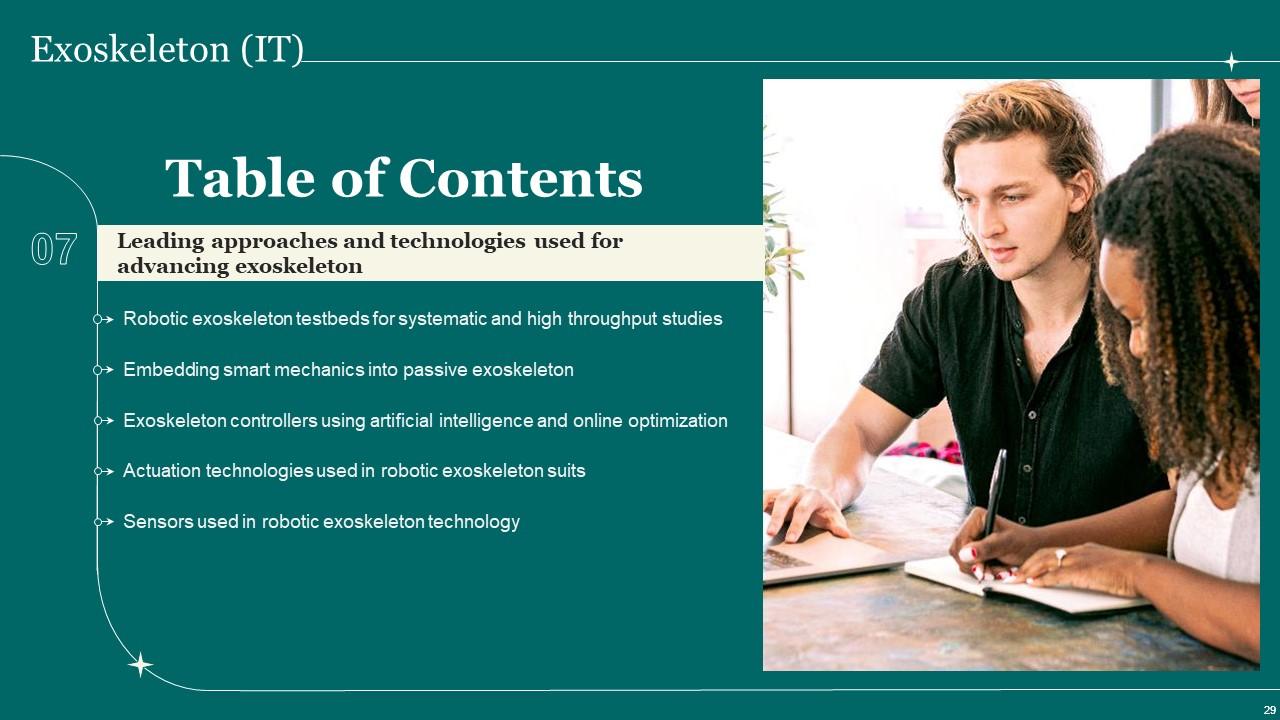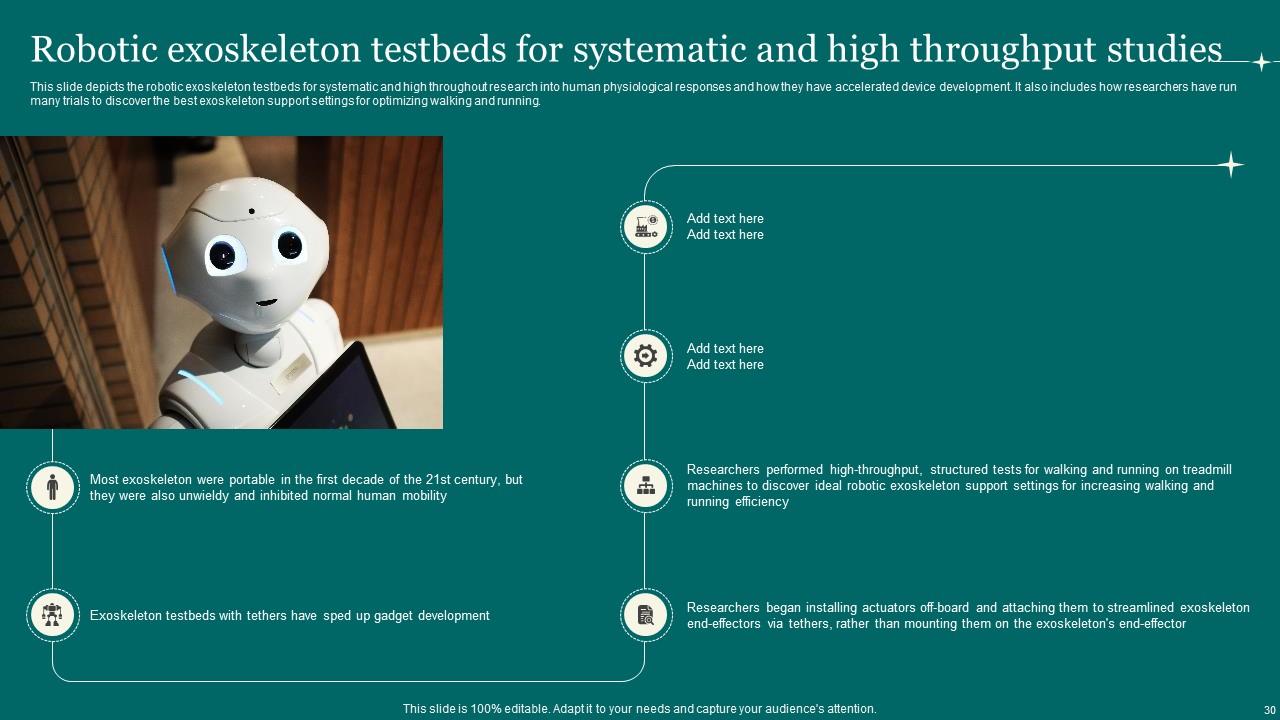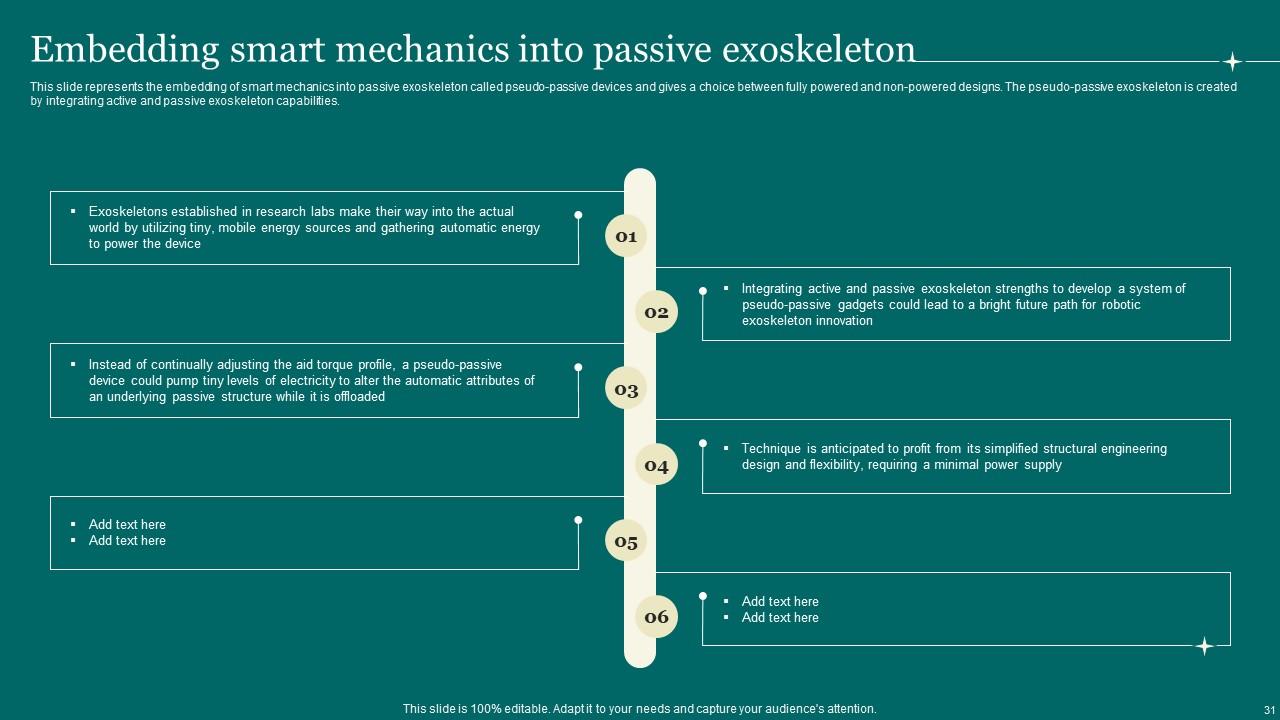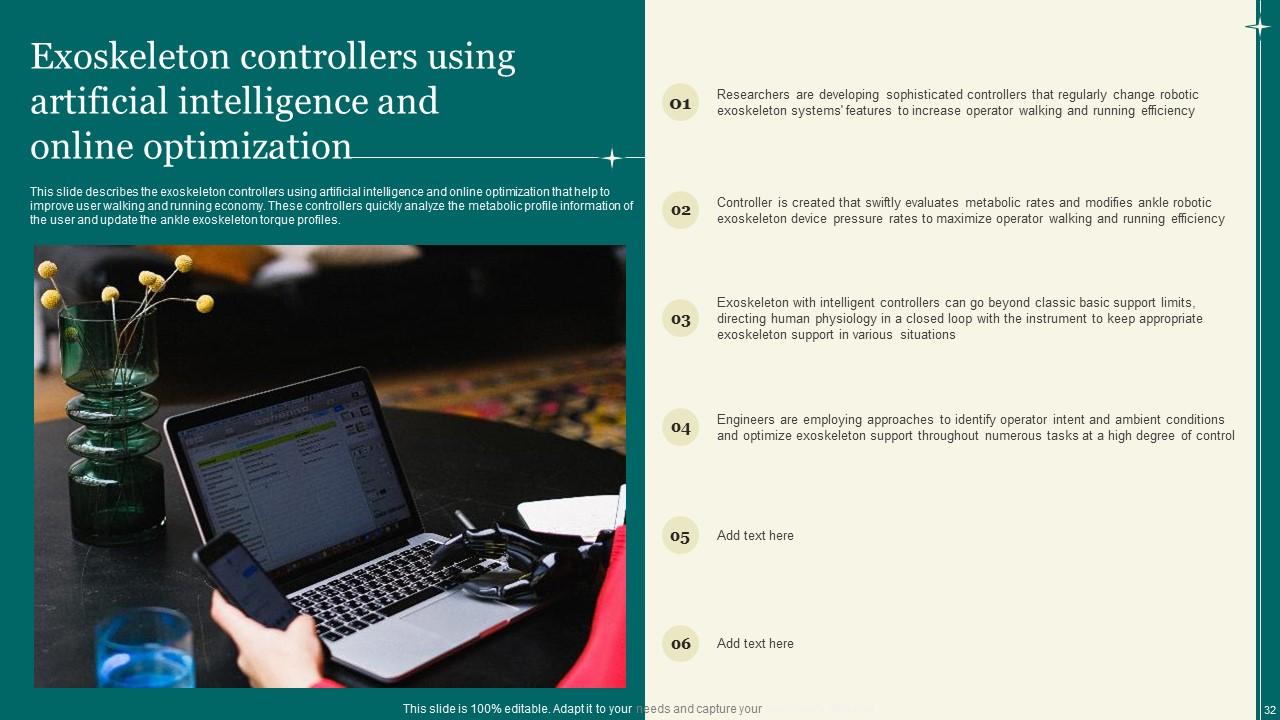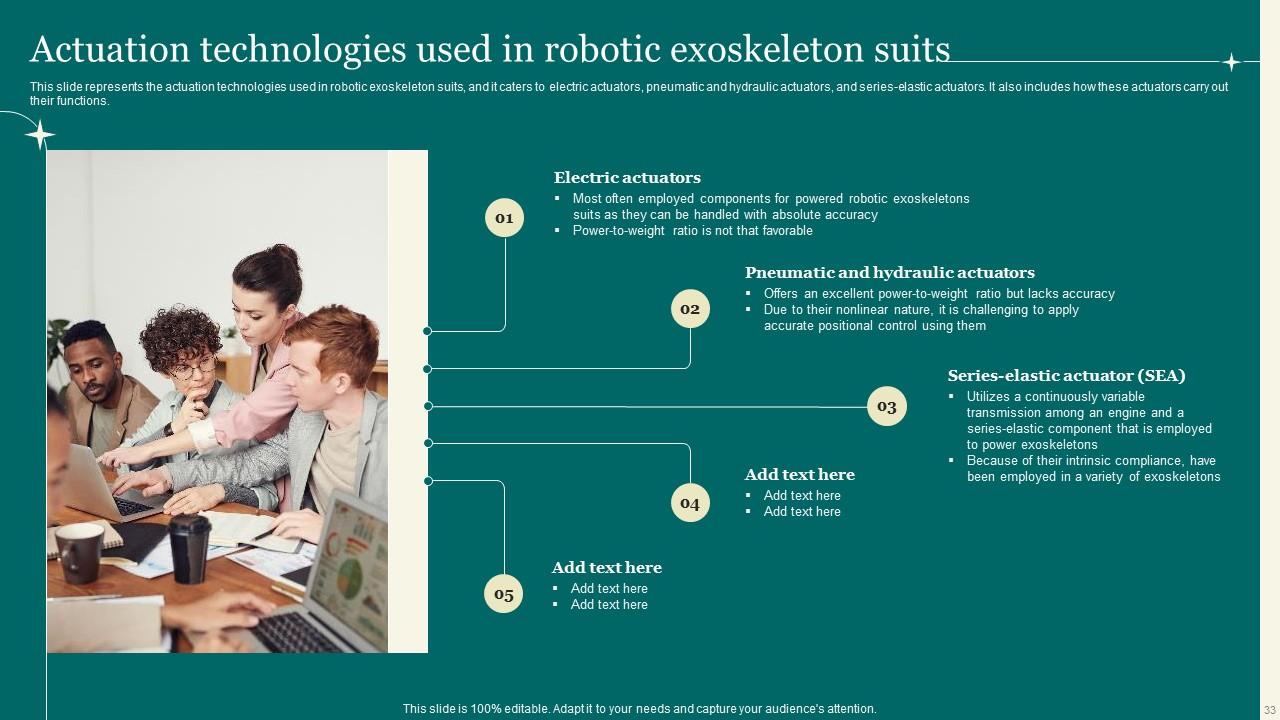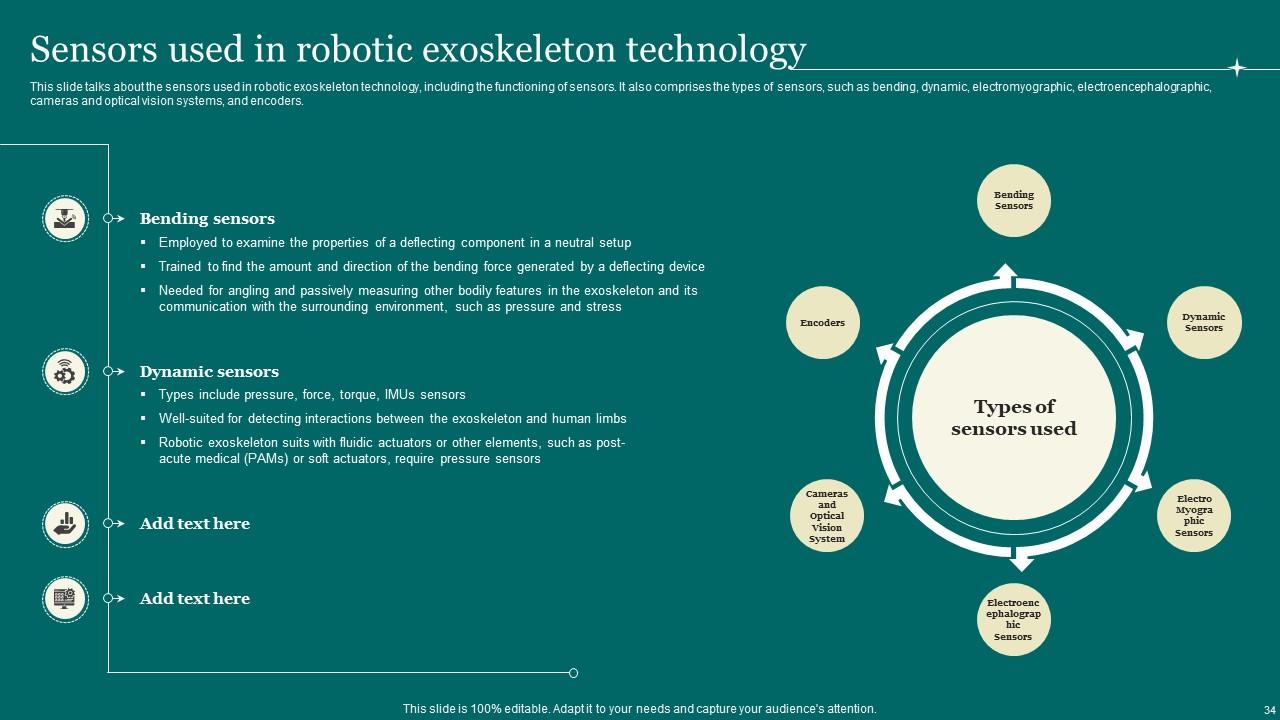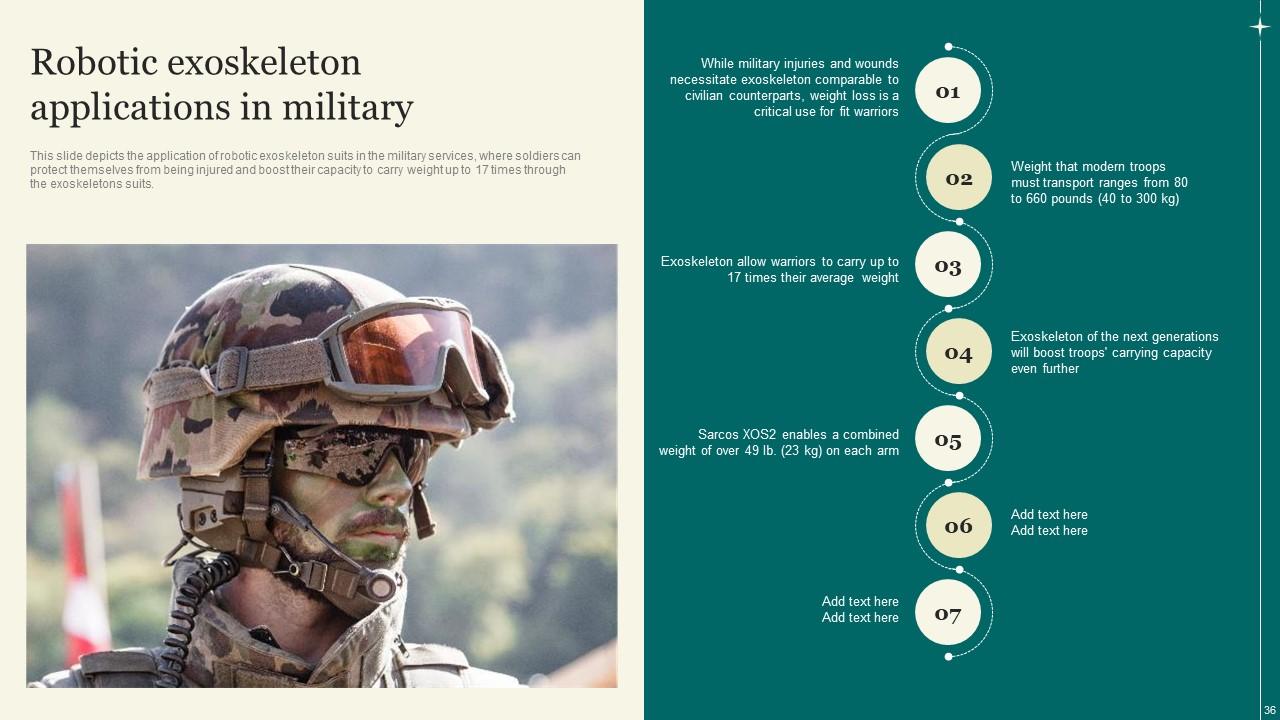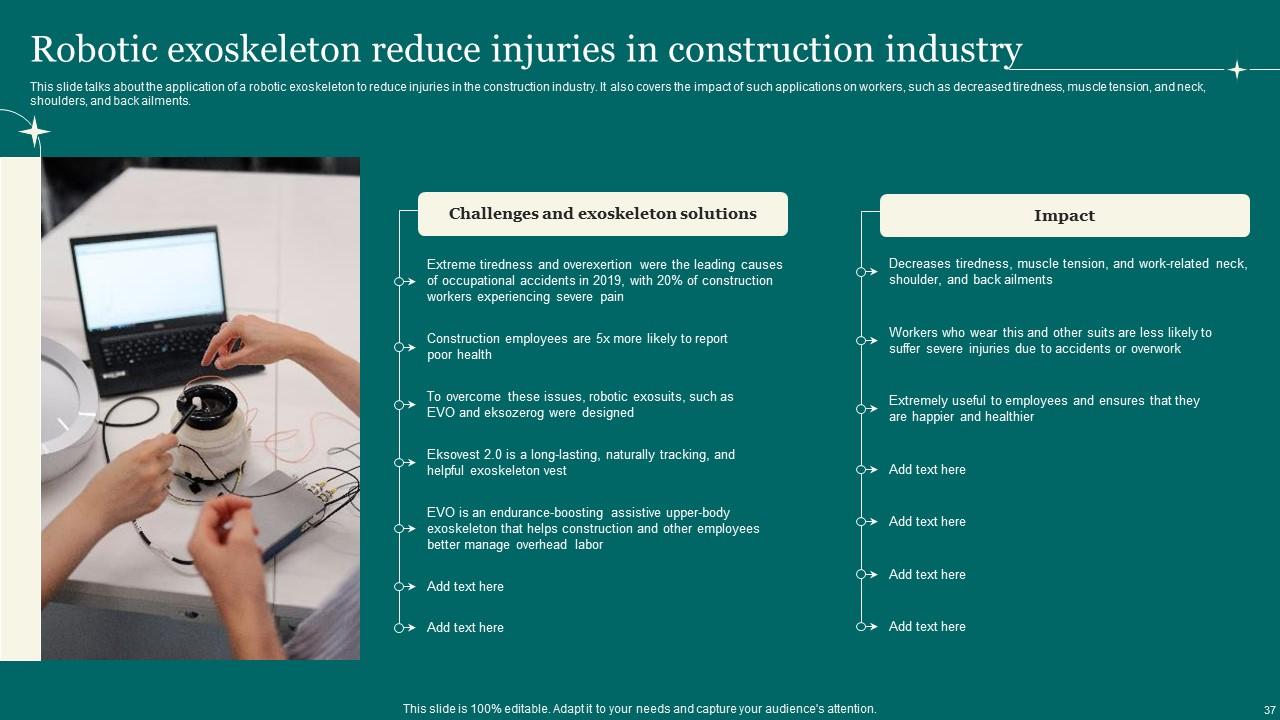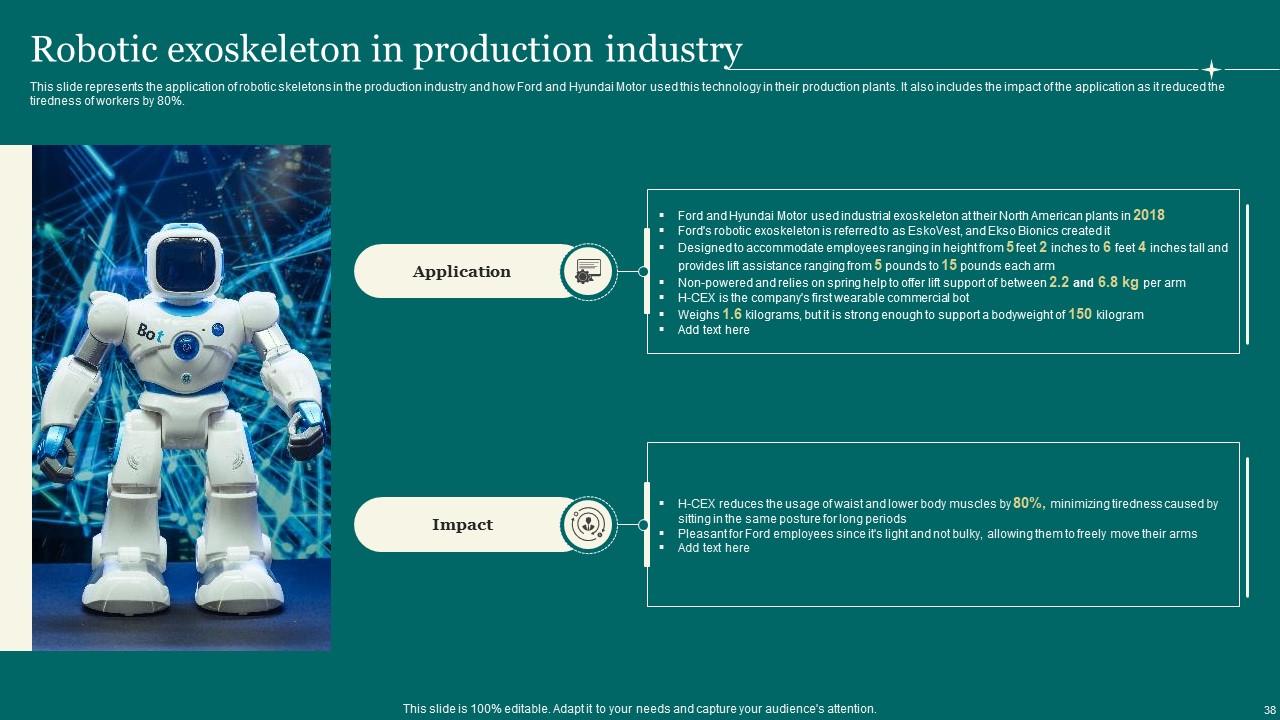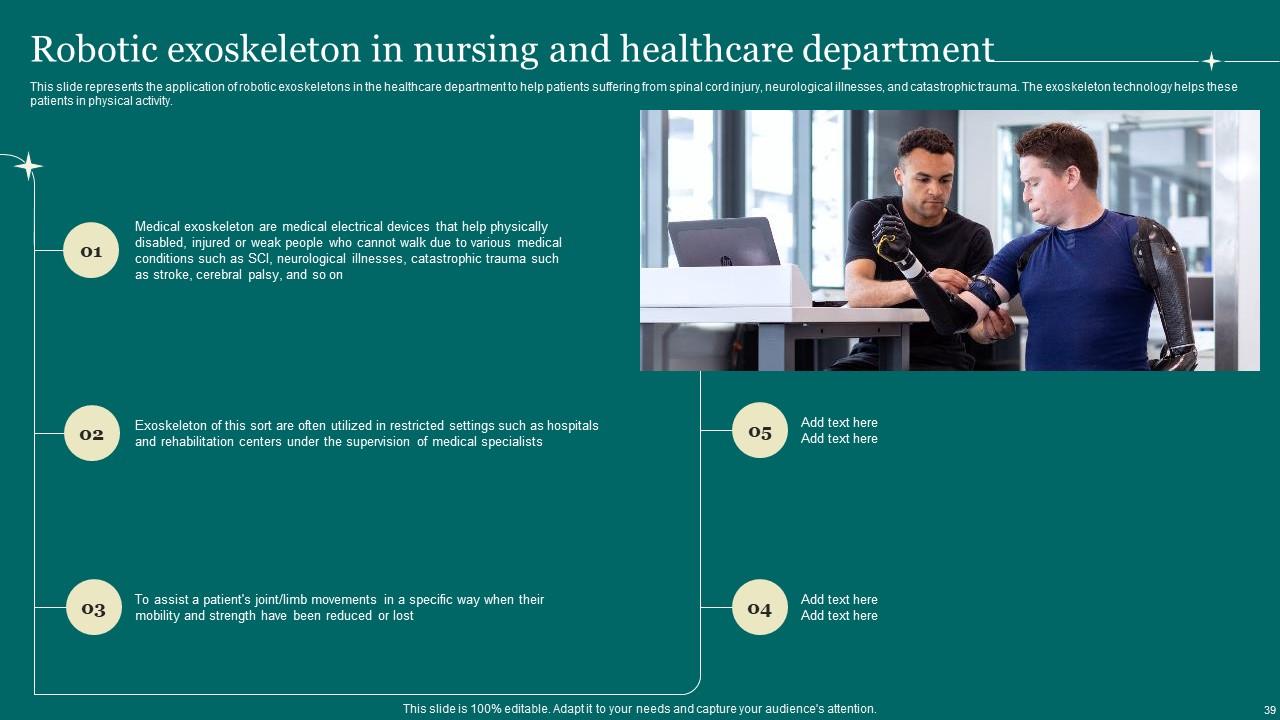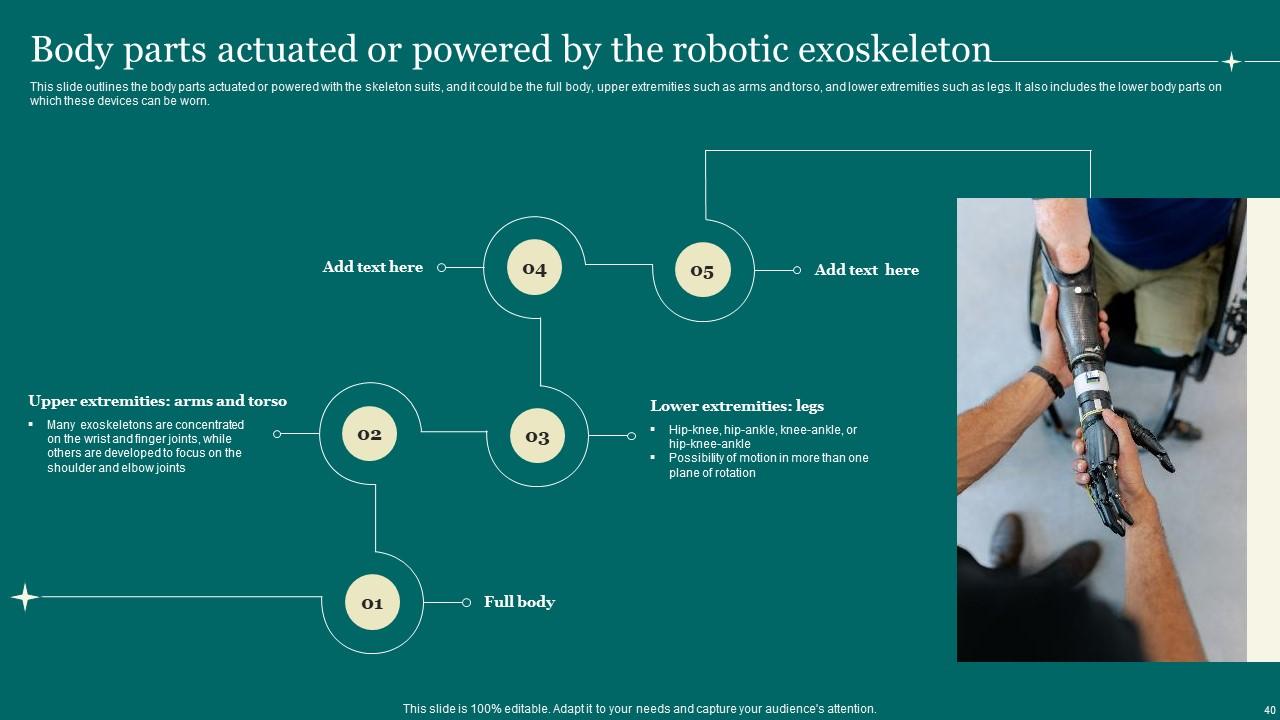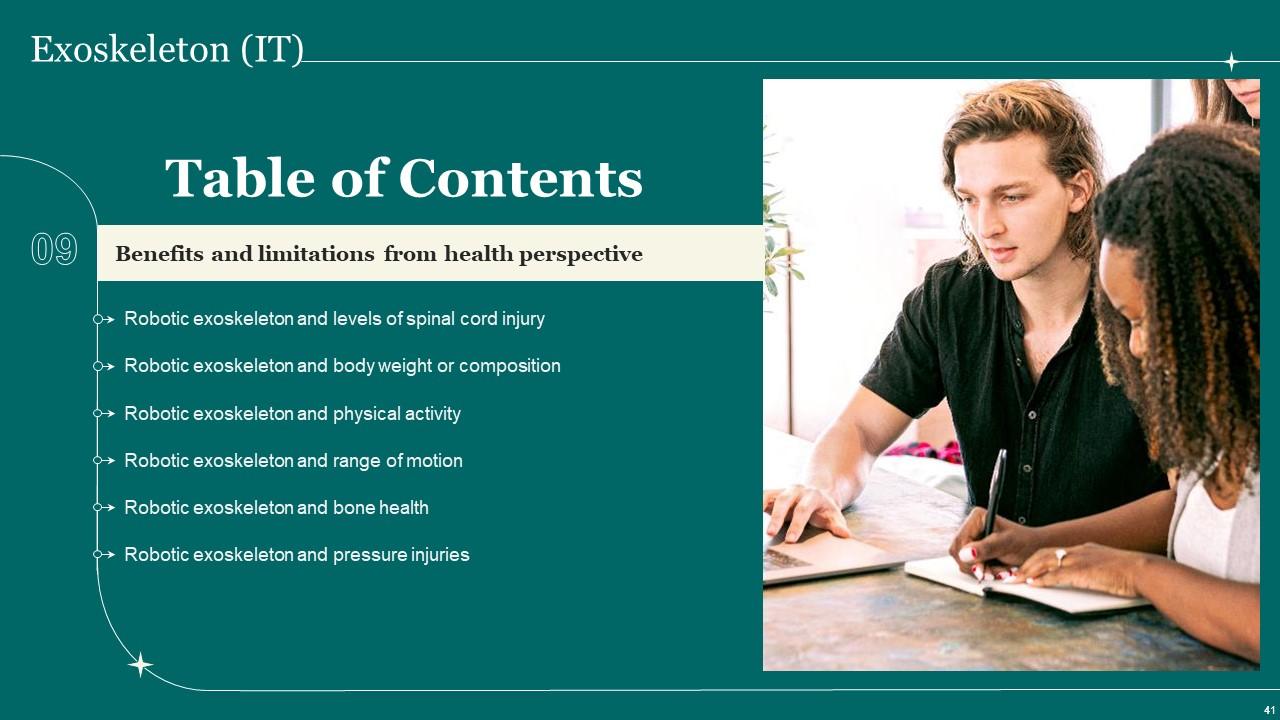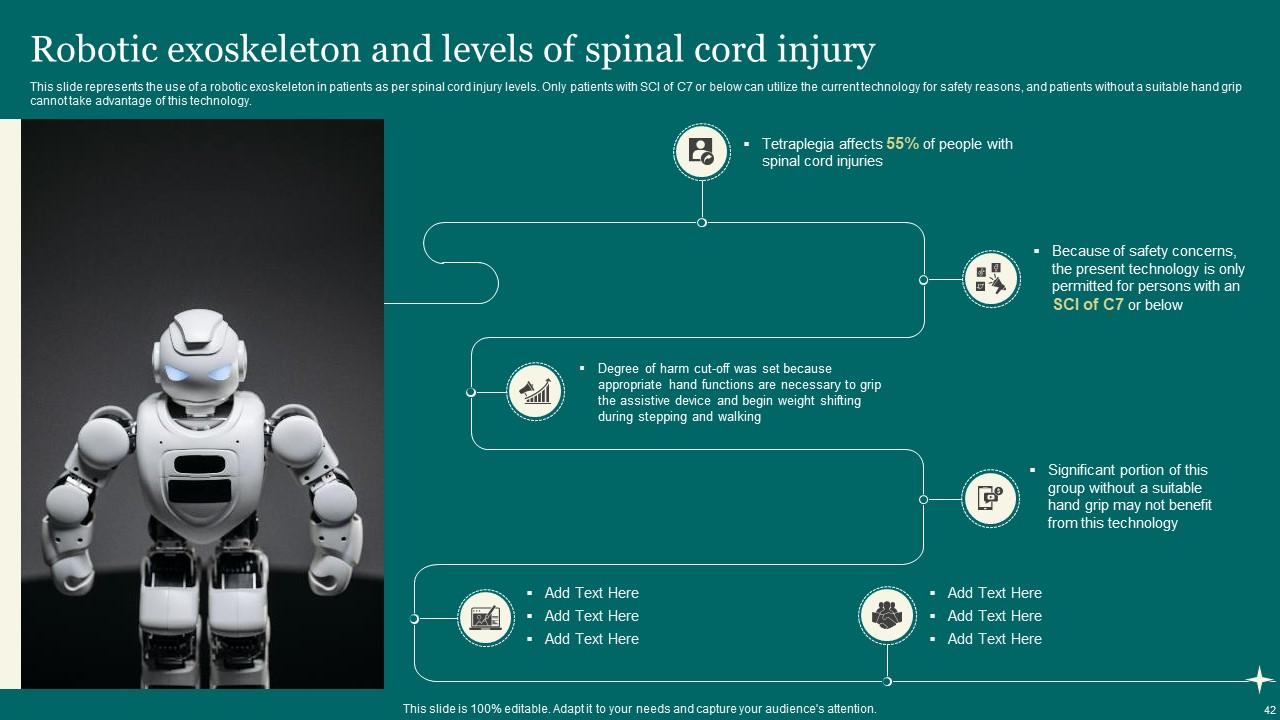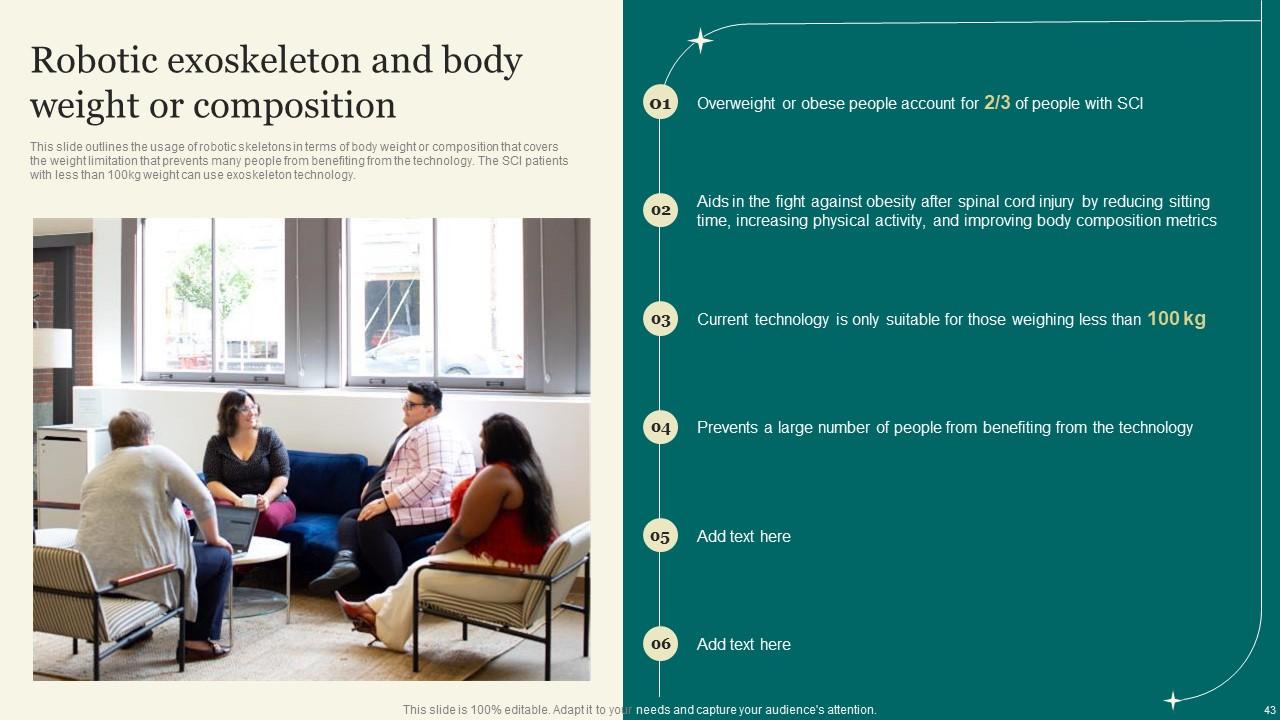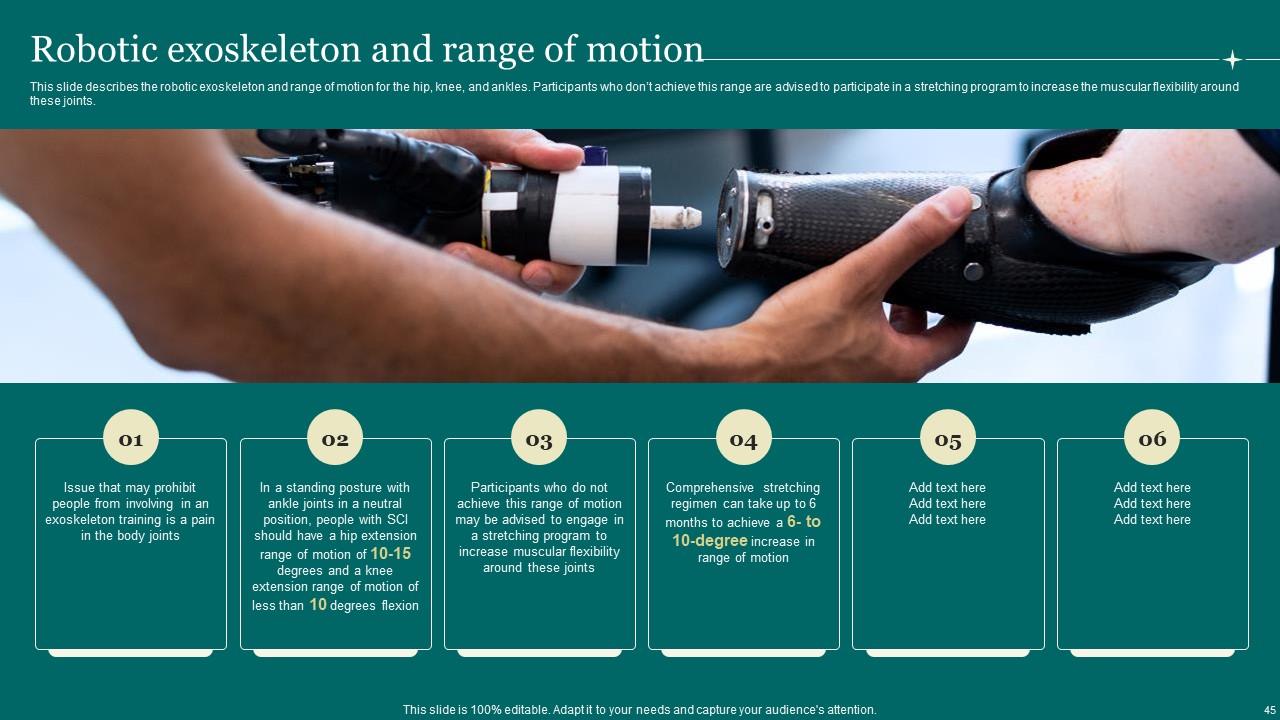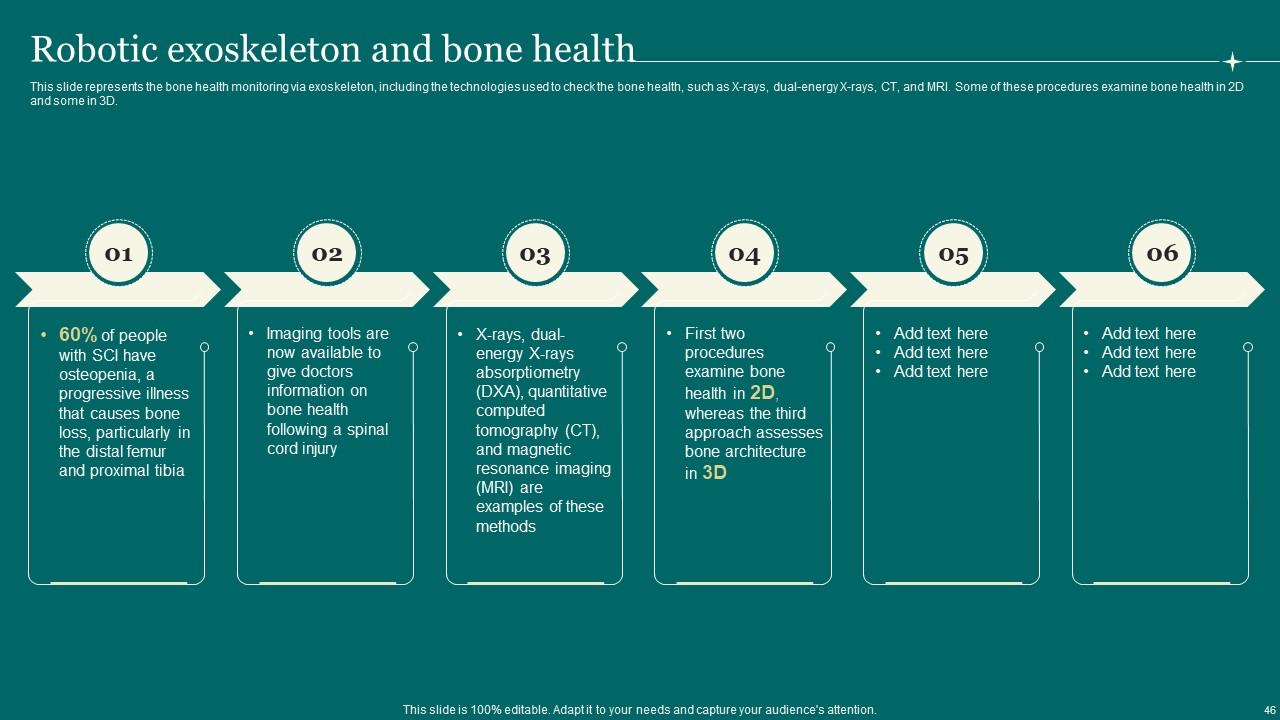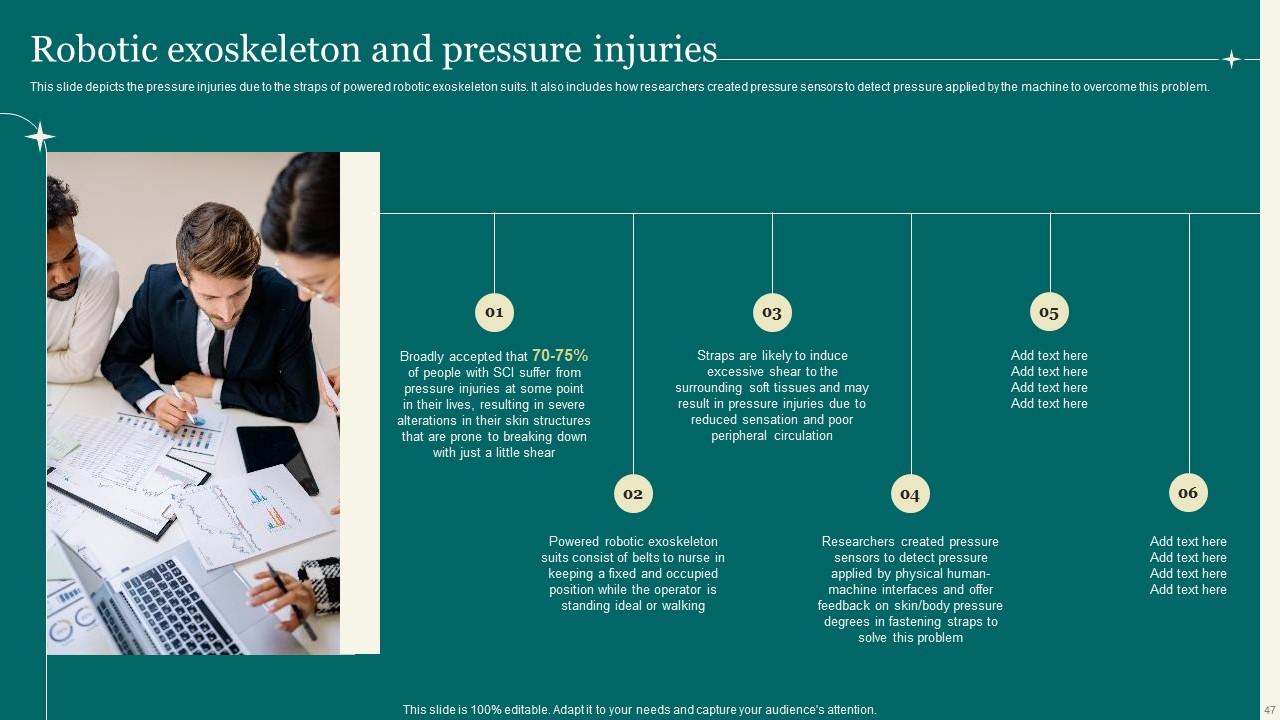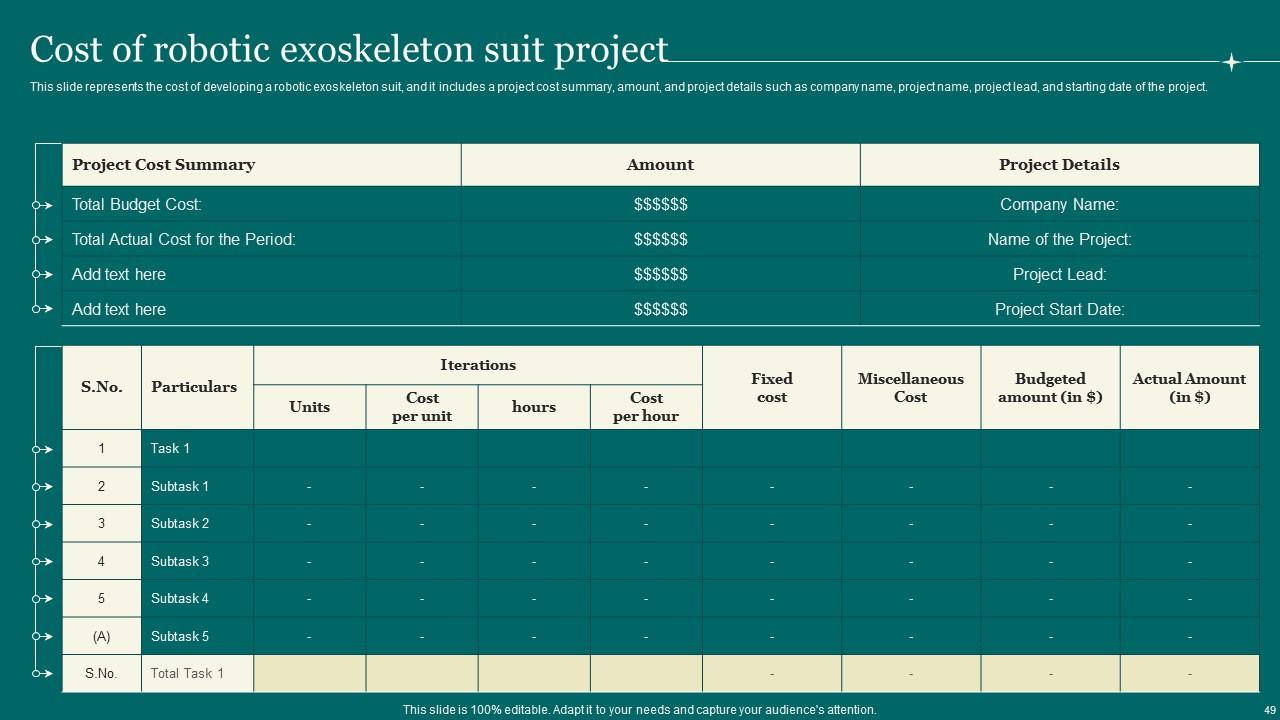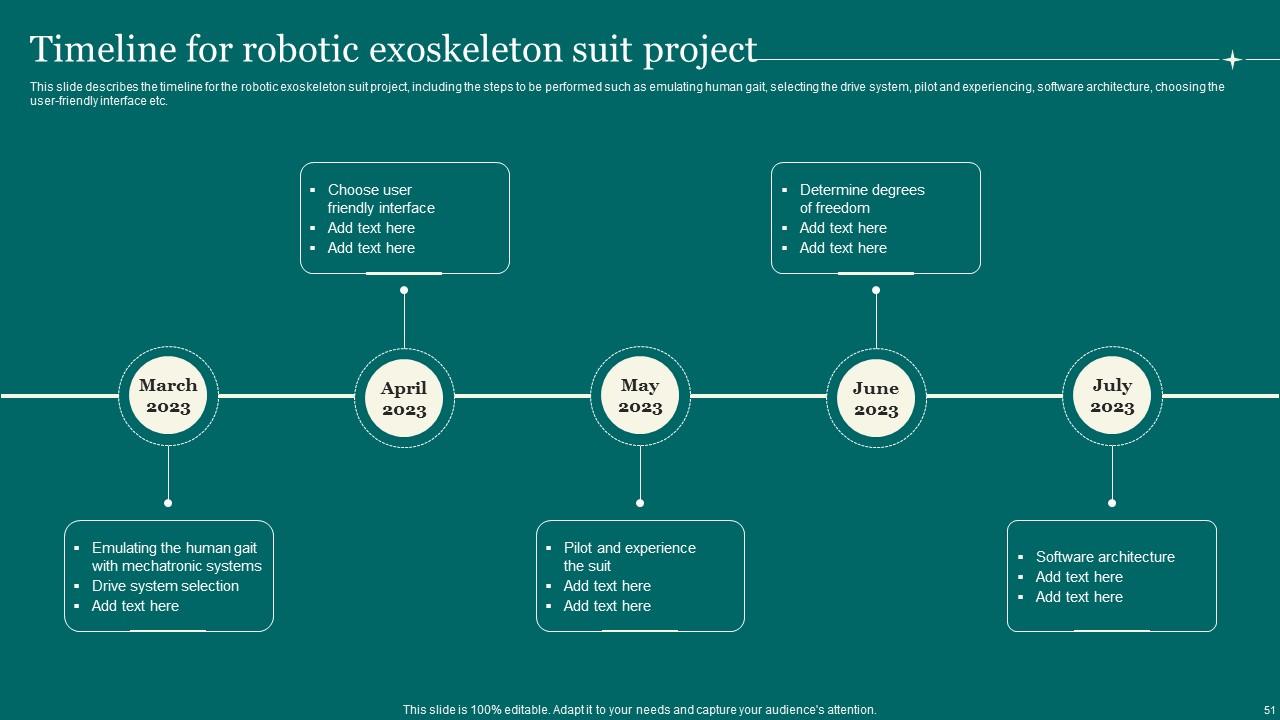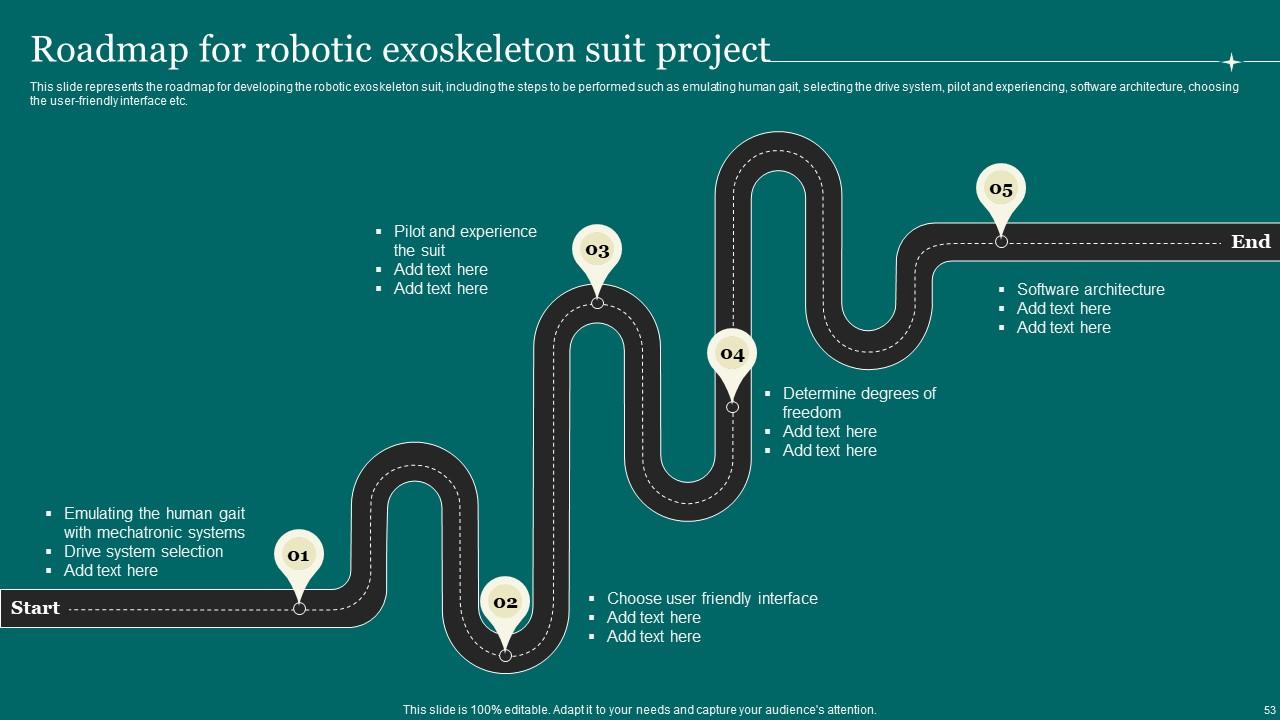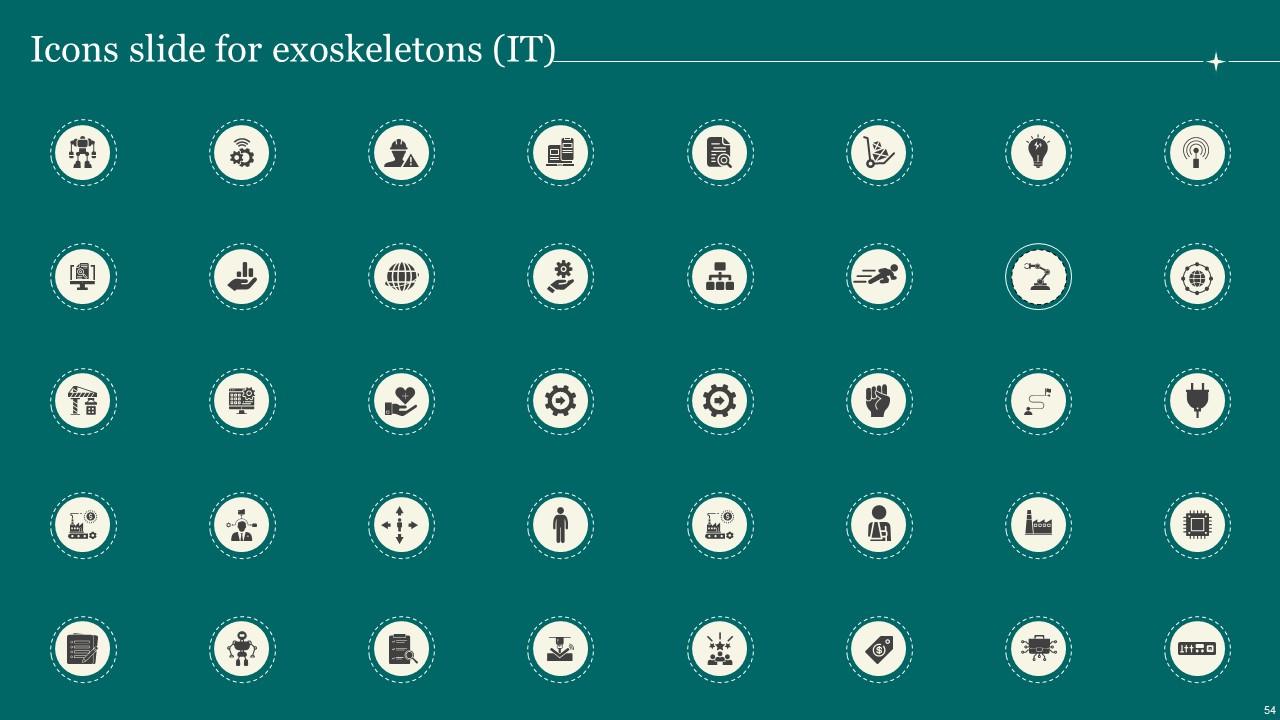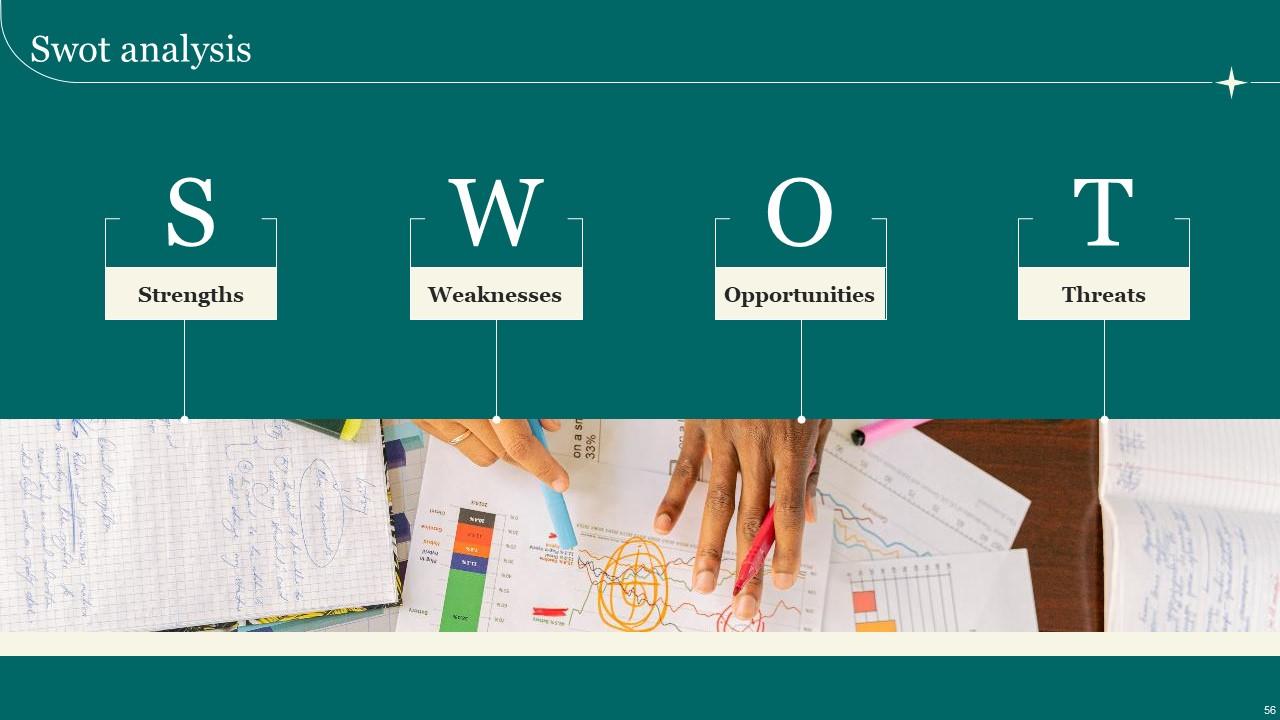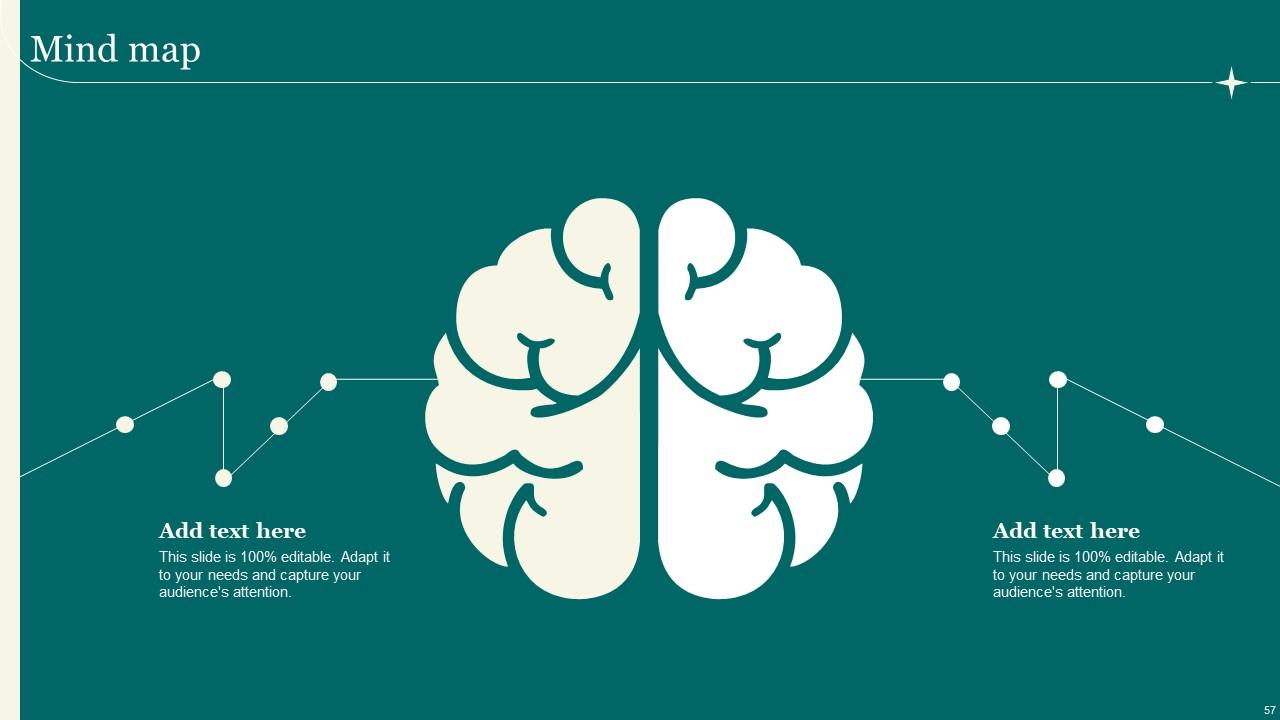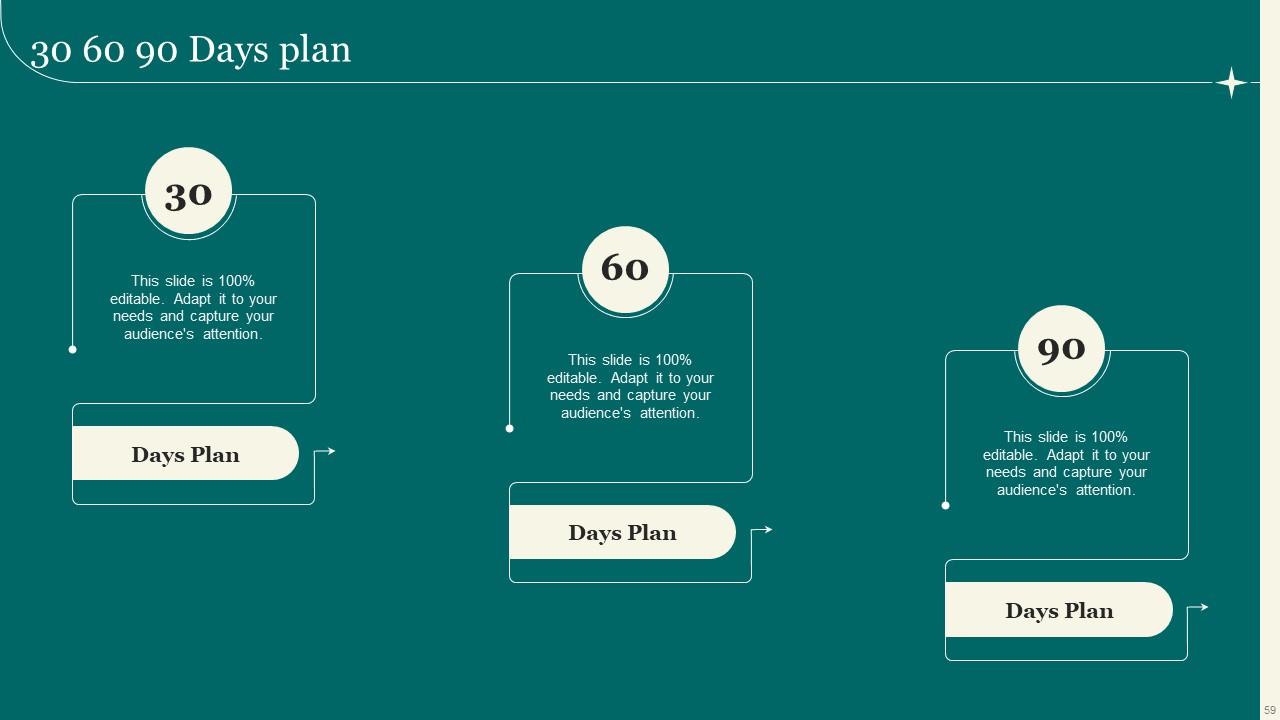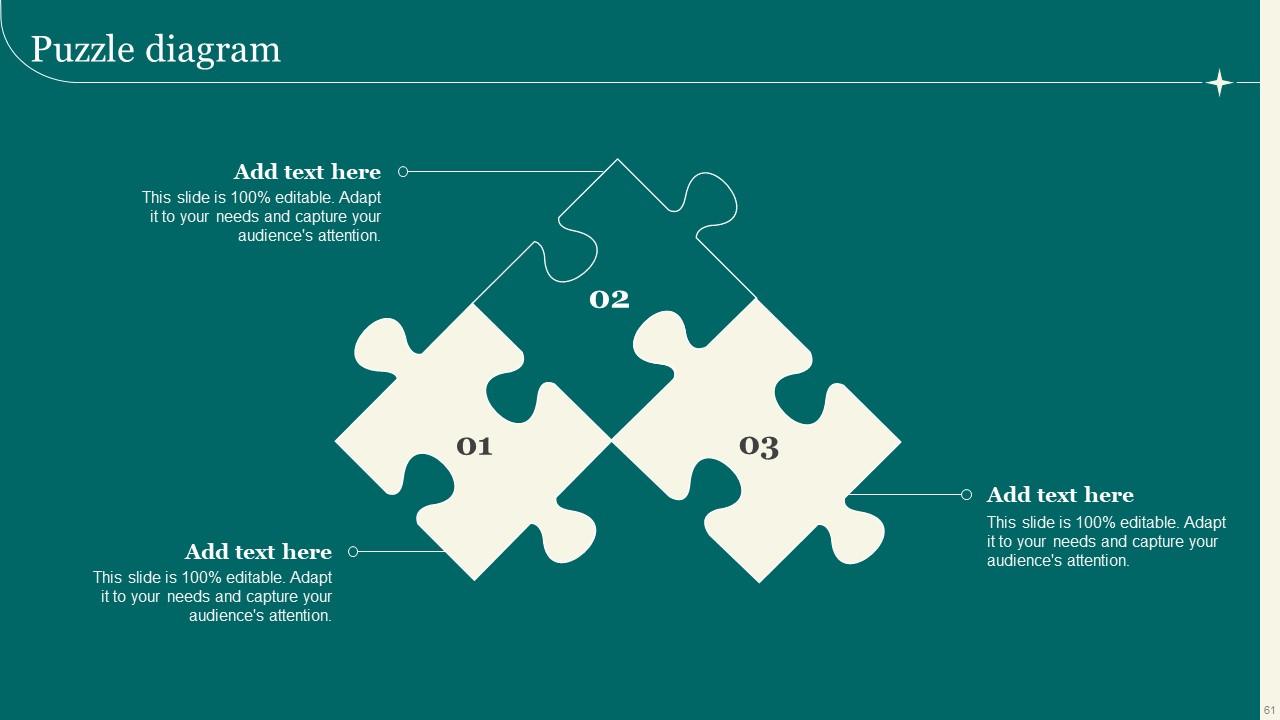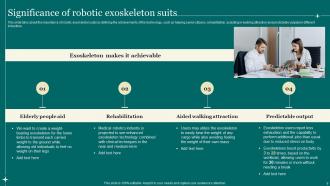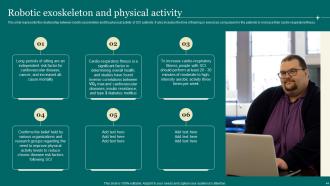Exoskeleton IT Powerpoint Presentation Slides
This PowerPoint presentation gives a brief idea about the robotic exoskeleton provider company, its unique values and solutions, and its importance and market share of the robotic exoskeleton. Also, it incorporates presents the overview covering the introduction, growth timeline, advantages, and disadvantages. In this Exoskeleton PowerPoint Presentation, we have covered the various types of robotic exoskeletons, such as powered exoskeleton, passive exoskeleton, pseudo passive exoskeleton, hybrid exoskeleton, and artificial intelligence and smart sensors robotic exoskeleton. It also includes the exoskeleton wearable robots that are rigid and soft exo suits. In addition, this Powered Exoskeletons PPT contains the working, controlling, and materials used in robotic exoskeleton. It comprises of leading approaches and technologies for advancing exoskeletons, such as testbeds, embedding smart mechanics into passive exoskeletons, exoskeleton controllers using AI, and online optimization. Also, the Exoskeleton PPT presentation includes the applications of robotic exoskeletons in different sectors, including the military, construction and production industry, and medical departments. It also contains a special section describing the benefits and limitations from a health perspective. Furthermore, this Locomotion template caters to the cost of developing a robotic exoskeleton suit, a timeline, and a roadmap. Download our 100 parcent editable and customizable template, which is also compatible with Google Slides.
This PowerPoint presentation gives a brief idea about the robotic exoskeleton provider company, its unique values and solut..
- Google Slides is a new FREE Presentation software from Google.
- All our content is 100% compatible with Google Slides.
- Just download our designs, and upload them to Google Slides and they will work automatically.
- Amaze your audience with SlideTeam and Google Slides.
-
Want Changes to This PPT Slide? Check out our Presentation Design Services
- WideScreen Aspect ratio is becoming a very popular format. When you download this product, the downloaded ZIP will contain this product in both standard and widescreen format.
-

- Some older products that we have may only be in standard format, but they can easily be converted to widescreen.
- To do this, please open the SlideTeam product in Powerpoint, and go to
- Design ( On the top bar) -> Page Setup -> and select "On-screen Show (16:9)” in the drop down for "Slides Sized for".
- The slide or theme will change to widescreen, and all graphics will adjust automatically. You can similarly convert our content to any other desired screen aspect ratio.
Compatible With Google Slides

Get This In WideScreen
You must be logged in to download this presentation.
PowerPoint presentation slides
Deliver an informational PPT on various topics by using this Exoskeleton IT Powerpoint Presentation Slides. This deck focuses and implements best industry practices, thus providing a birds-eye view of the topic. Encompassed with sixty two slides, designed using high-quality visuals and graphics, this deck is a complete package to use and download. All the slides offered in this deck are subjective to innumerable alterations, thus making you a pro at delivering and educating. You can modify the color of the graphics, background, or anything else as per your needs and requirements. It suits every business vertical because of its adaptable layout.
People who downloaded this PowerPoint presentation also viewed the following :
Content of this Powerpoint Presentation
Slide 1: This slide introduces Exoskeleton (IT). Begin by stating Your Company Name.
Slide 2: This slide depicts the Agenda of the presentation.
Slide 3: This slide includes the Table of contents.
Slide 4: This slide elucidates the Title for the Topics to be covered further.
Slide 5: This slide represents the overview of the robotic exoskeleton manufacturing company.
Slide 6: This slide depicts the organization's unique values and solutions.
Slide 7: This slide describes the robotic exoskeleton representative team of the manufacturing company.
Slide 8: This slide highlights the Heading for the Contents to be discussed further.
Slide 9: This slide talks about the importance of robotic exoskeleton suits by defining the achievements of the technology.
Slide 10: This slide represents the global market size of robotic exoskeletons from 2015 to 2025.
Slide 11: This slide provides information about the growing robotic exoskeleton market from 2021 to 2023.
Slide 12: This slide contains the Title for the Ideas to be covered in the upcoming template.
Slide 13: This slide presents the overview of robotic exoskeleton that are wearable robotics systems and widely used in healthcare departments and households.
Slide 14: This slide depicts the generic architecture of a robotic exoskeleton.
Slide 15: This slide highlights the timeline for the growth of robotic exoskeletons in recent years from 2018 to 2022.
Slide 16: This slide deals with the advantages of a robotic exoskeleton.
Slide 17: This slide discusses the disadvantages of robotic exoskeleton suits.
Slide 18: This slide potrays the Title for the Topics to be discussed in the upcoming template.
Slide 19: This slide depicts the powered exoskeleton type of robotic exoskeleton and the hardware components used in it.
Slide 20: This slide describes the passive type of robotic exoskeletons that boost a user’s mobility with springs or other sources of motor force.
Slide 21: This slide represents the other two types of a robotic exoskeleton that are pseudo-passive exoskeletons and hybrid exoskeletons.
Slide 22: This slide talks about the artificial intelligence and smart sensors robotic exoskeleton suit.
Slide 23: This slide indicates the Heading for the Components to be covered further.
Slide 24: This slide reveals the overview of exoskeleton wearable robots and their types.
Slide 25: This slide displays the overview of soft exo-suit wearable robots that are made of supple material and are of minimal weight.
Slide 26: This template focuses on the Title for the Topics to be discussed in the forth-coming slide.
Slide 27: This slide presents the working of a robotic exoskeleton with the human body.
Slide 28: This slide showcases the ways of controlling robotic exoskeleton suits.
Slide 29: This slide incorporates the Heading for the Ideas to be covered next.
Slide 30: This slide depicts the robotic exoskeleton testbeds for systematic and high throughout research into human physiological responses and how they have accelerated device development.
Slide 31: This slide provides the information about embedding of smart mechanics into passive exoskeleton called pseudo-passive devices and gives a choice between fully powered and non-powered designs.
Slide 32: This slide describes the exoskeleton controllers using artificial intelligence and online optimization that help to improve user walking and running economy.
Slide 33: This slide represents the actuation technologies used in robotic exoskeleton suits, and it caters to electric actuators, pneumatic and hydraulic actuators, and series-elastic actuators.
Slide 34: This slide talks about the sensors used in robotic exoskeleton technology, including the functioning of sensors.
Slide 35: This slide reveals the Title for the Topics to be covered further.
Slide 36: This slide depicts the application of robotic exoskeleton suits in the military services.
Slide 37: This slide deals with the application of a robotic exoskeleton to reduce injuries in the construction industry.
Slide 38: This slide represents the application of robotic skeletons in the production industry and how Ford and Hyundai Motor used this technology in their production plants.
Slide 39: This slide states the application of robotic exoskeletons in the healthcare department.
Slide 40: This slide outlines the body parts actuated or powered with the skeleton suits, and it could be the full body, upper extremities.
Slide 41: This slide indicates the Heading for the Contents to be discussed further.
Slide 42: This slide represents the use of a robotic exoskeleton in patients as per spinal cord injury levels.
Slide 43: This slide outlines the usage of robotic skeletons in terms of body weight or composition that covers the weight limitation that prevents many people from benefiting from the technology.
Slide 44: This slide exhibits the relationship between robotic exoskeleton and the physical activity of SCI patients.
Slide 45: This slide describes the robotic exoskeleton and range of motion for the hip, knee, and ankles.
Slide 46: This slide reveals the bone health monitoring via exoskeleton.
Slide 47: This slide depicts the pressure injuries due to the straps of powered robotic exoskeleton suits.
Slide 48: This slide elucidates the Title for the Topics to be covered in the upcoming template.
Slide 49: This slide displays the cost of developing a robotic exoskeleton suit project.
Slide 50: This slide mentions the Heading for the Ideas to be discussed next.
Slide 51: This slide describes the timeline for the robotic exoskeleton suit project.
Slide 52: This slide highlights the Title for the Topics to be covered further.
Slide 53: This slide represents the roadmap for developing the robotic exoskeleton suit project.
Slide 54: This is the Icons slide showcasing all the Icons used in the plan.
Slide 55: This slide is used for depicting some Additional information.
Slide 56: This slide presents the Company's Swot analysis.
Slide 57: This slide illustrates the Mind map of the organization.
Slide 58: This is Our Mission slide. State your organization's mission, vission, and goal here.
Slide 59: This slide indicates the 30 60 90 Days plan for effective planning.
Slide 60: This slide provides information on the Financial topic.
Slide 61: This slide depicts the Puzzle diagram for more relevant Company information.
Slide 62: This is the Thank You slide for acknowledgement.
Exoskeleton IT Powerpoint Presentation Slides with all 67 slides:
Use our Exoskeleton IT Powerpoint Presentation Slides to effectively help you save your valuable time. They are readymade to fit into any presentation structure.
FAQs
Robotic exoskeletons are wearable devices that are designed to assist, support, or augment the human body's movement. They are usually made of lightweight materials and are powered by motors and batteries.
Robotic exoskeletons can provide numerous benefits, including increased mobility, improved strength and endurance, reduced pain and fatigue, and improved quality of life. They can also be used for rehabilitation purposes and can help people with disabilities or injuries regain their independence.
Robotic exoskeletons are generally safe to use when they are designed and manufactured according to safety standards. However, they should only be used under the guidance of trained professionals to ensure that they are being used correctly and safely.
Robotic exoskeletons can benefit a wide range of people, including those with spinal cord injuries, strokes, multiple sclerosis, and other neurological or musculoskeletal disorders. They can also be used by workers in physically demanding jobs to reduce the risk of injury and improve productivity.
The cost of robotic exoskeletons varies depending on the manufacturer, model, and features. Some models can cost tens of thousands of dollars, while others may be more affordable. Insurance providers may cover some or all of the cost of a robotic exoskeleton in certain cases.
-
Wide collection of templates available. SlideTeam has made it easier to create presentations in just a few minutes.
-
My search for complete decks ended with SlideTeam. Such a surplus collection of HD PowerPoints. Moreover, their standard and widescreen formats have helped me in delivering bullseye presentations.


